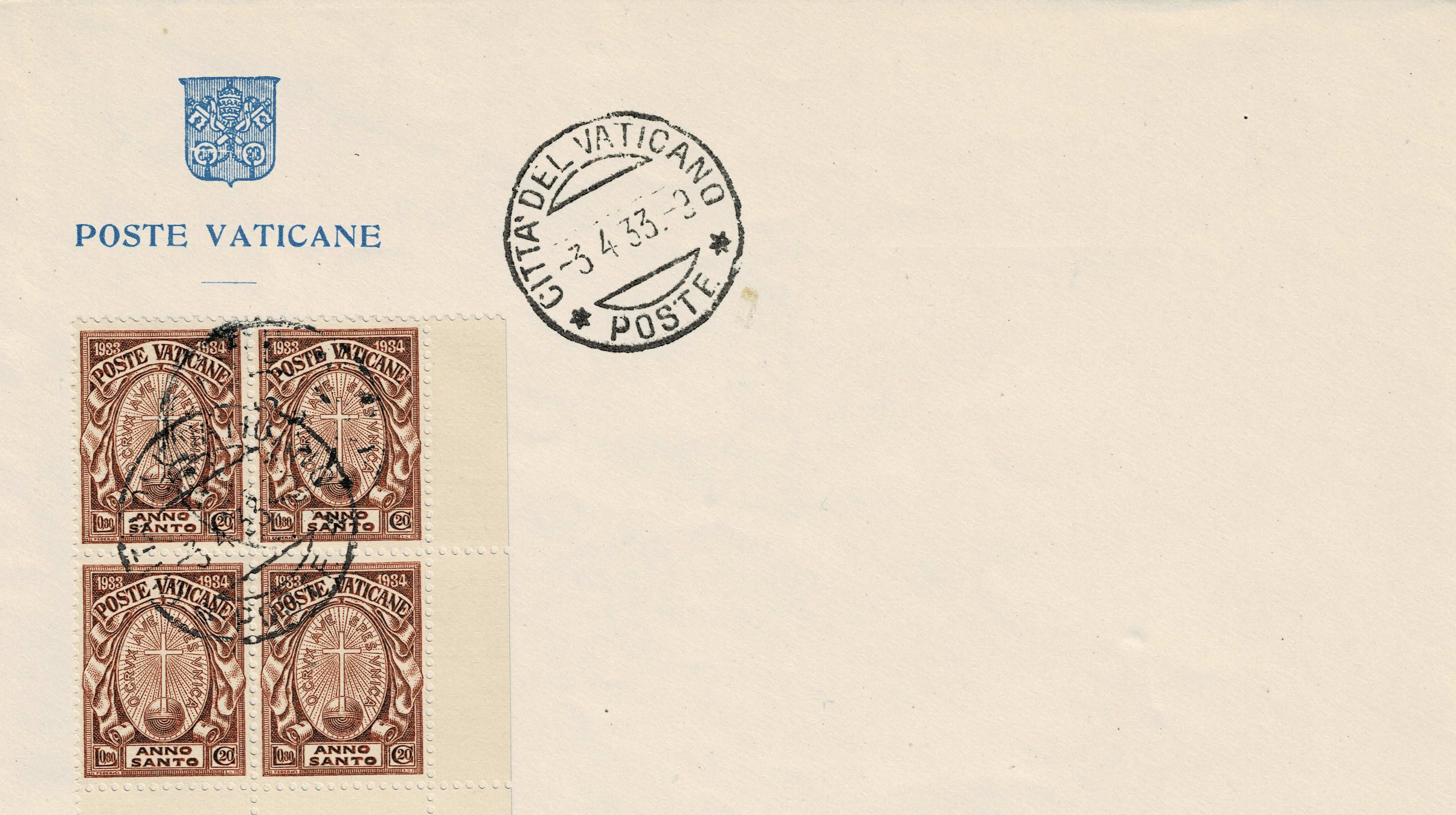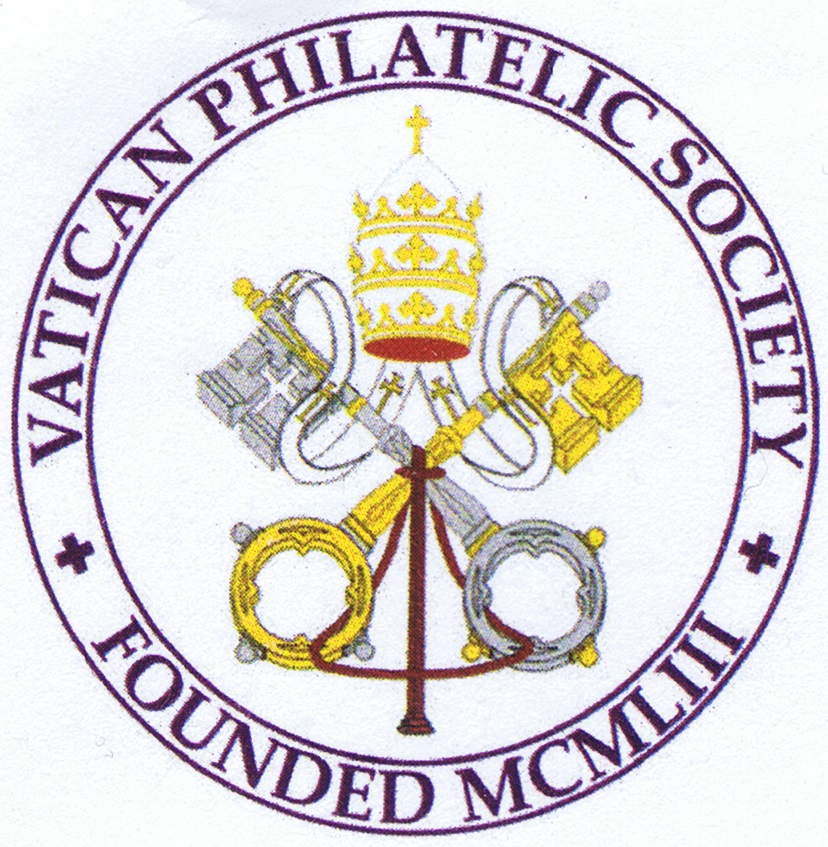
Member

Below is a 1954 article written by William Wonneberger Jr., founder of the Vatican Philatelic Society (VPS). The text is exactatly as he wrote it. The stamp images are from VPS website files. The first-day cover images are also from the VPS website image files and are the much appreciated contributions of several VPS members. We are greatful to the Cardinal Spellman Philatelic Museum for allowing the Vatican Philatelic Society to use this copyrighted material on our website.
This article was originally published by the National Philatelic Museum (of Philadelphia) which sponsored a Vatican Marian Year Philatelic Exhibition from September 22 through November 5, 1954. The exhibit was under the patronage of His Eminence Frances Cardinal Spellman, Archbishop of New York, in cooperation with the Vatican City Postal Administration. Cardinal Spellman is also listed as being the 1,000th member of the Vatican Philatelic Society. In conjunction with the Marian Exhibition, this article was published by the National Philatelic Museum's journal (Volume VII, Number 1, pages 61-107), edited by Ernest A. Kehr. When the National Philatelic Museum folded, assets were transferred to the Cardinal Spellman Philatelic Museum.
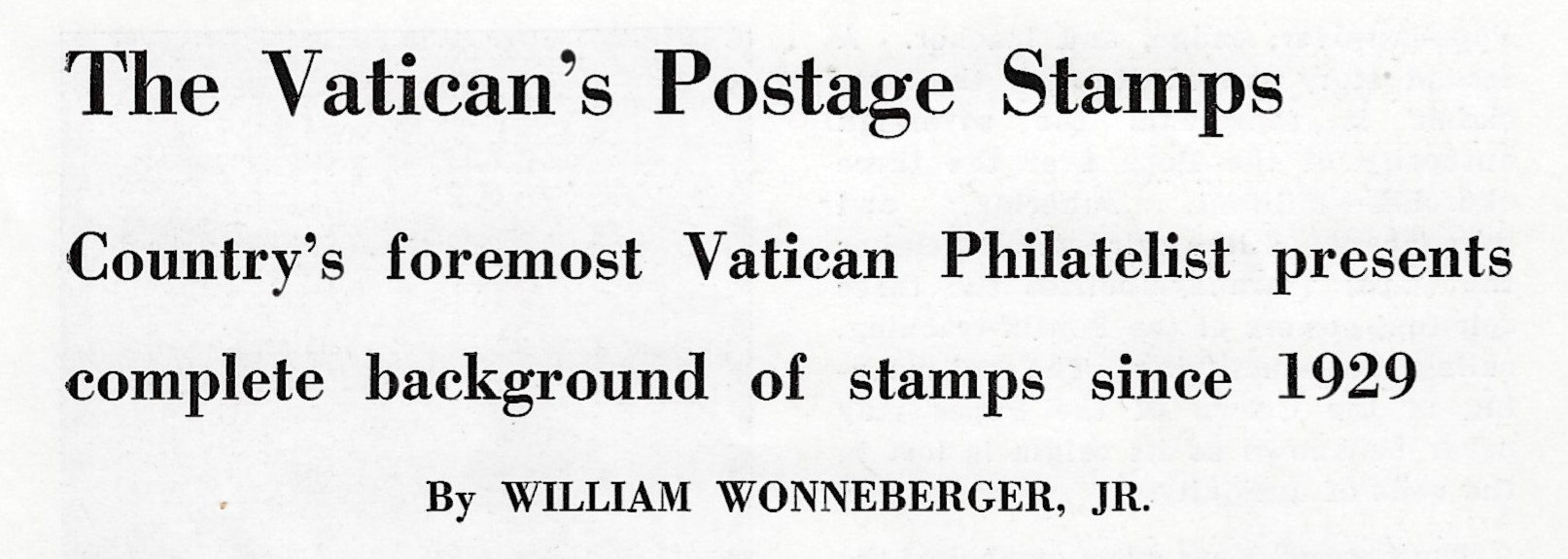















The Conciliation Issue:
Vatican City's First Stamps
August 1, 1929, saw the release of the first stamps of the then newly created State of Vatican City. The issue was composed of fifteen values, seven of the thirteen regular stamps depicted the Papal Tiara and Crossed Keys of St. Peter while the six higher ordinary stamps and the two special delivery stamps depict the reigning Pontiff at that time, His Holiness, Pope Pius XI.
The Papal Tiara, or triple crown as it is sometimes called, is a tall head-dress of gold cloth ornamented with precious stones, encircled with three coronets and surmounted by a cross. The original tiara consisted of a plain helmet-like cap of white material and was provided with its first circlet about 1130 A. D. The second was added during the Pontificate of Pope Boniface VIII (1294-1303). The earliest representation of the tiara with three crowns is found on the effigy of Pope Benedict XII who died in 1342. The tiara's earliest name, Camelaucum (made of camel's hair) would indicate it was of Byzantine origin and was probably adopted by the Popes of the seventh or eighth century from the Byzantine court head-dress, the Ramelankion.
Tradition claims that the Papal Tiara symbolizes the three major roles of the Pope-lawgiver, judge, and teacher. A second story passed through the ages claims it represents the sovereign authority of the Pope over the three churches: militant, suffering, and triumphant. Still a third version claims the Papal Tiara symbolizes the three spiritual powers of the Pontiff-teaching, ruling, and sanctifying. The real meaning of the Crown of the Popes may never be known as its origin is lost in the veils of antiquity.
The Crossed Keys are a symbol of the power and authority of the Pope as successor of Peter, to whom Christ said, ". . . And I will give to thee the Keys to the Kingdom of Heaven." The Keys also are a symbol of the Sacrament of Penance. Saint Peter at times is represented with one key, the Key to Heaven; with two gold or silver keys to represent the power to absolve and bind; with two gold or iron keys to open the gates of heaven and hell; and again with one key to symbolize dominion over heaven, earth, and hell. The six high values of the Conciliation issue along with the two special delivery stamps bears an effigy of His Holiness, Pope Pius XI. It was through his efforts that a solution to the Roman Question was found by the Treaty of the Conciliation, more commonly known as the Lateran Pact. Immediately after his election, in 1922, Pius XI showed a willingness to arrive at a compromise with Italy by giving his Apostolic blessing, "Urbi et Orbi," from the outer balcony of St. Peter's Basilica, thus breaking the tradition of the Popes since the fall of Rome in 1870. The Italian government recognized this sign and approached the Holy Father as to his intentions. At irregular intervals, Conselor of State Barone, representing the Italian government, and Francesco Pacelli, representing the Holy Father, met again and again to draw a suitable treaty. The entire agreement was studied and revised at least twenty times before it was presented to the Chamber of Representatives and Pope Pius XI. The final draft was not satisfactory as presented and led to more than two hundred protracted audiences before it was finally signed on February 11, 1929. There actually were two documents of the Lateran Pact, first a treaty establishing a new nation, the tiniest in the world, the State of Vatican City. The second document was a concordat guaranteeing that Italian civil laws were not to conflict with Canon Law, as well as other minor provisions. This pact, though signed in February, did not go into effect until noon of June 7, 1929.
This tiny nation was a far cry from the old Papal States, which at one time comprised more than half of the Italian peninsula and several islands. However, it was all the territory the Holy Father desired. The Italian government had offered more but he declined saying, "I do not wish subjects." His chief reason for seeking restoration of temporal power was to secure freedom of action in conducting the affairs of the Church. In addition to the Vatican, Pius XI became temporal ruler of various pieces of territory outside of the Vatican proper. This included the Lateran Palace, various basilicas in Rome, the catacombs, and Castelgondolf o, the summer home of the Popes.
With the settlement of the Roman Question, Pius XI set about to erect the necessary buildings to conduct the affairs of the new nation. Among the new buildings erected were: the railroad station (a gift of the Italian government), radio station, government palace, enlargement of the post and telegraph offices, installation of modern communications, and remodeling the existing structures. For his work of creating the Vatican nation and his role in supervising its construction, Pius XI is reverently called, "The Builder Pope."
In 1931, the thirty centesimi value of this issue was surcharged with a new value of twenty-five centesimi to help meet the demand for such a denomination to prepay the postal card rate.
Again, in 1934, the six values of the ordinary values depicting Pius XI were surcharged to conform with the increased postal rates. In addition to the two different surcharges applied to various stamps of this issue, there were three different overprints applied. As these overprints changed the stamps' purpose they will be mentioned separately.
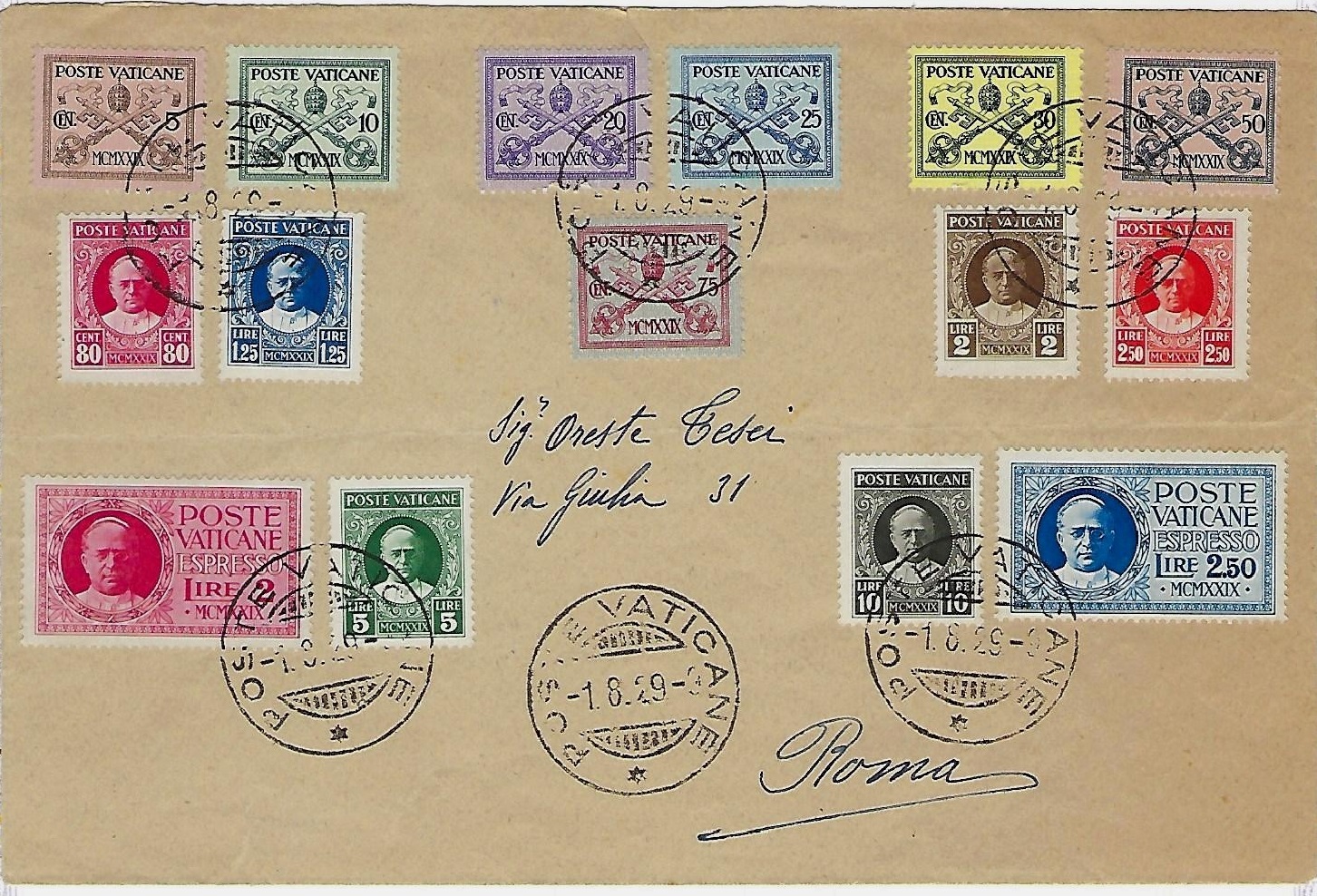



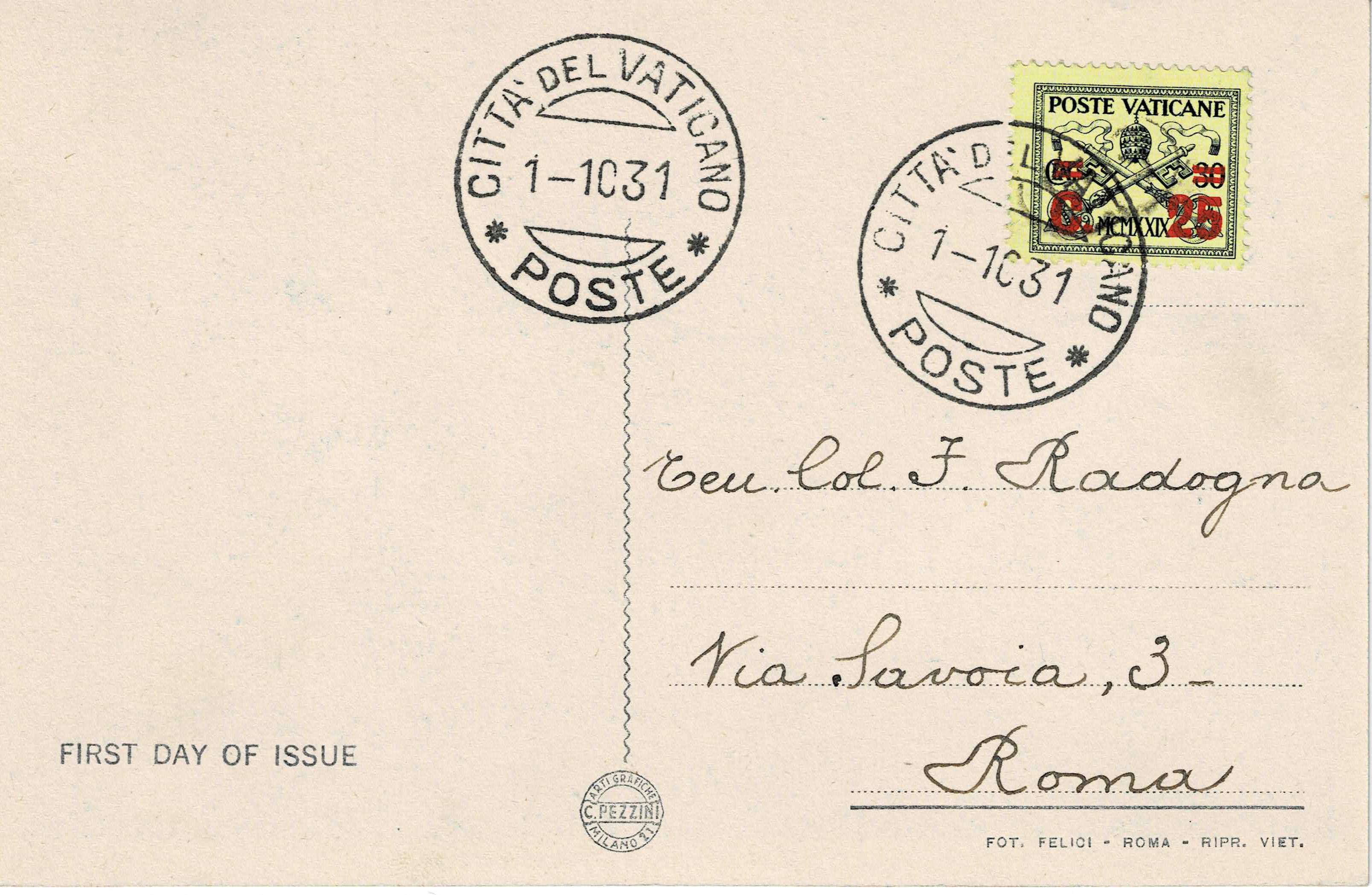
















Definitives of 1933
By order of the Vatican Governor dated May 20, 1933, the release of a new set of ordinary stamps was decreed. They were first placed on sale eleven days later, on May 31, 1933.
The Arms of Pius XI are depicted on the 5 centesimi value surmounted by the Papal Tiara and Crossed Keys against arabesque background. The Apostolic Palace forms the motif for the 10, 12 20, and 25 centesimi values. The palace was a simple dwelling at first, erected by Pope Symmachus, in the fifth century. Subsequent Popes added to the structure and by the fourteenth century it had assumed the proportions of a palace. As it now stands, the Apostolic Palace is a group of buildings covering thirteen and one half acres to the north of St. Peter's and to the east of the Vatican Gardens. Among its some twenty courts and one thousand halls, chapels, and apartments will be found the Sistine Chapel, containing Michelangelo's famed "Last Judgement" on the rear wall. In other parts of the palace will be found the Chiarmonti Gallery, the Etruscan, Egyptian, and Pagan Museums where the priceless relics of the past ages are to be viewed with awe. The palace also houses the world renowned Vatican Library. About fifty thousand manuscripts and well over three hundred fifty thousand books are housed in this, the most American of all libraries in Europe.
The scene that graces the 80, 50, 75, and 80 centesimi values is a view of the Vatican Gardens. The part of the gardens depicted is the Avenue of the Foundations with the characteristic palm tree. In reality, there are two gardens, the new and the old. The old gardens were begun so long ago their origin is lost in the annals of history. They are formally laid out in a series of vistas with irregular paths that often lead to a boxwood inglenook where a statue stands in a shady corner. The new gardens are less formally laid out. Here a vast assortment of flowers greets the viewer's eyes with great stretches of open green lawns dotted with rose gardens, and those laid out in the classic Italian patterns to finish the picture. The new gardens are kept fresh and flowering by modern irrigation. One central tap controls the spray of thirty-two acres of hidden lawn fountains.
The two gardens combined cover approximately a quarter of the total area of the Vatican State.
The 1, 1.25, 2, and 2.75 lire values of this depict the reigning Pontiff, Pope Pius XI. Pius XI entered this world early in the morning of May 31, 1857 in the commune of Desio, Italy, and baptized Ambrose Damien Achille. He spent a great deal of his childhood with his uncle who was the parish priest of Asso. His schooling passed rapidly and at the age of twenty-two he was ordained in the Church of San Carlo al Corso, in Rome, on December 20, 1879. A postgraduate course at the Gregorian University brought to young Achille the Doctorates of Theology, Philosophy, and Canon Law. In 1888 the future Pope was appointed to the Faculty of Doctors of the Ambrosian Library, in Milan. After serving in this capacity for nineteen years he was chosen Prefect. The year 1913 saw Father Ratti summoned to the Vatican by Pope Benedict XV, to serve as assist-ant prefect of the Vatican Library. A year later he became the Library's Prefect and Canon of the Archbasilica of St. Peter. At the age of fifty-seven he was raised to the rank of Monsignor. When Poland requested a Papal representative in 1918, Monsignor Ratti was sent by Pope Benedict XV. A year later a Nunciature was established in Warsaw with the recently elevated Archbishop Ratti serving as the Papal Nuncio. Some time later he was bestowed with the red hat and appointed Cardinal Archbishop of his Archdiocese of Milan, to which he returned on November 8, 1921. Exactly 150 days later he ascended to the Throne of St. Peter to serve a remarkable pontificate of seventeen years as Pope Pius XI, the 260th successor of St. Peter.
The high values, 5, 10 and 20 lire stamps depict the Square of St. Peter's. The square is open at the front with two curved colonades straightening out before reaching the Basilica roughly in the shape of a keyhole. Two hundred and eighty four columns in four rows supporting nothing but one hundred sixty-four purely ornamental statues, architecturally, it seems absurd, but yet this art of building is the masterpiece of the famed Bernini, and forms a fitting approach to the final resting place of the body of St. Peter, the first Pope. In the center of the square stands an Egyptian obelisk with a crowning bronze cross containing a fragment of the True Cross. The obelisk is surrounded by a double row of small pillars to protect it from traffic. Flanking the obelisk are the fountains, spouting water fifteen to twenty feet into the air.
This colorful pictorial issue is completed with two special delivery stamps bearing an aerial view of the Vatican City State. This, the tiniest nation in the world, can best be described in the words of Pius XI, "That much territory we need as a basis for sovereignty; that much territory without which we could not exist; . . . that much body required to keep the soul together."







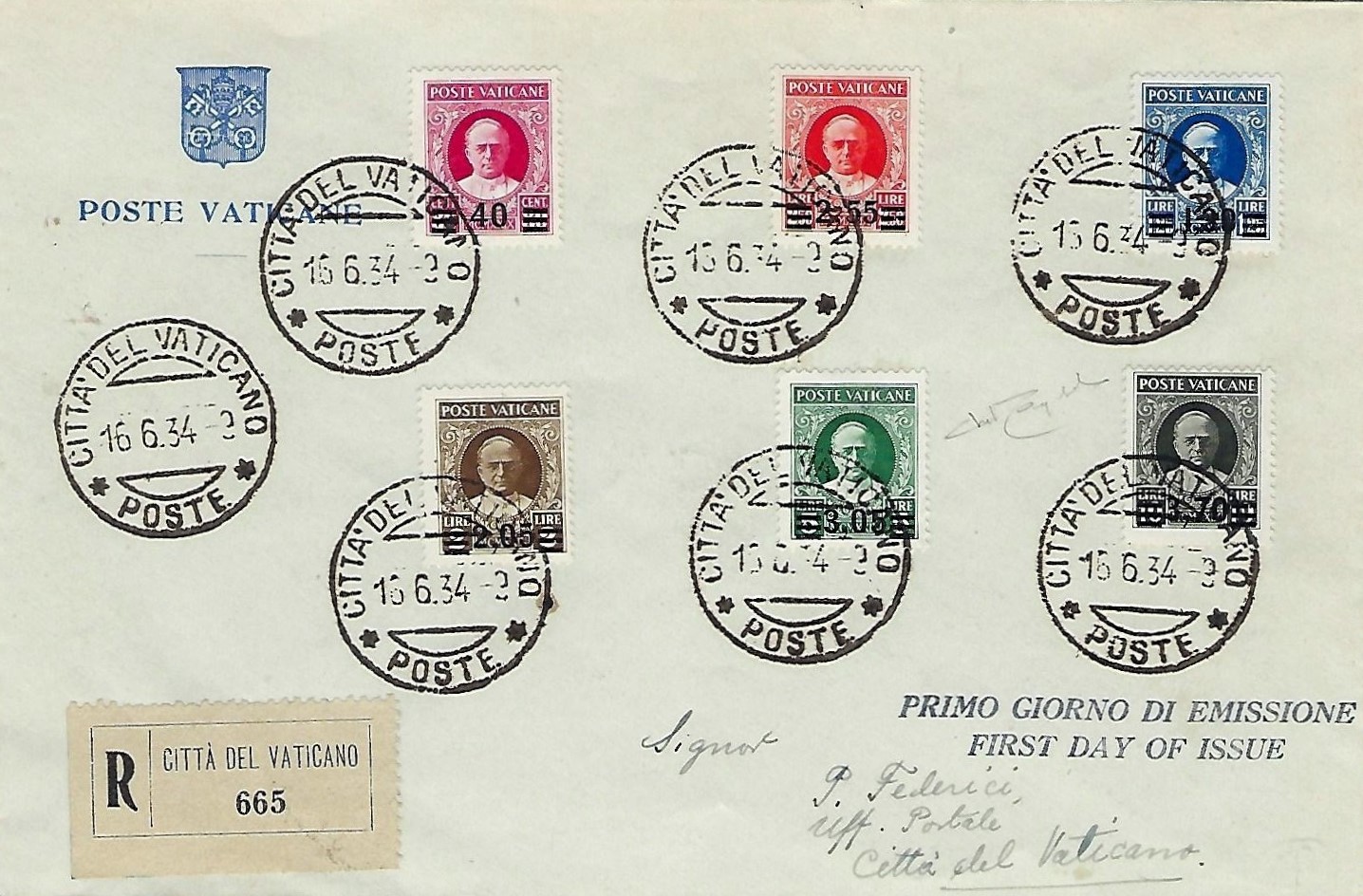






Juridical Congress
The International Juridical Congress convened in Rome in 1934 to mark the fourteenth centennial of the first codification of Roman Law. The Vatican Postal Administration marked this gathering with a set of six commemoratives of two major designs, each produced on three stamps of the issue. The first design depicts Tribonian presenting the pandects to Justinian I.
Justinian I, (Flavius Ancius Justinianus) was born in Tauresium, Dardania, Illyricum, on or about May 11, 483. In the year 527, by advice of his senate, his uncle Justine I proclaimed him a counsel and partner in his empire of Constantinople and Rome. Four months later Justinian succeeded him and became sole ruler of the empire. Immediately upon his accession to the throne, he set himself to the task of collecting and codifying the principal imperial constitutions and statutes in force at that time. When this was compiled Justinian turned his ambitions to the larger task of collecting the commentaries and other writings of the jurists to enable one treatise to digest and harmonize the rulings of the empire. The assembling of this data was entrusted to Tribonian who was assisted in this undertaking by the celebrated professor of law at Berytus, Theophilus. The codification was completed in four years and published in 50 volumes under the title of Digesta or Pandecta in the year 534. While it is this compilation that is depicted on the stamps of this issue, the Justinian Code consisted of four major parts:
1. The Pandects, a digest of the opinions and decisions of former jurists.
2. The Statute Law.
3. The Institutes, an abridgment In four volumes, of all the laws in elementary form.
4. The New Code, the laws in effect at that time as well as Justinian's own edicts.
Ten of the ablest lawyers of Justinian's reign aided in forming this famous digest of Roman law as compiled from the Gregorian, Theodorian, and Hermogenian codes. The completed code was submitted to the Emperor Justinian I fourteen years before his death on November 14, 565. The second design of this issue marks the seventh centennial of the promulgation of the Decretals by Pope Gregory IX.
Though the Decretals were a codification of Canon Law it was not the first attempt made to compile the ecclesiastical laws of the Church.
The first important and most celebrated collection of the canon laws was made by the monk Gratian, about the year 1150. It has been passed through the ages as the "Decree of Gratian." Though widely used and regarded as authoritative, the Decree of Gratian was never more than a private enterprise officially, since it was never regularly sanctioned or adopted by the Holy See.
Eighty-four years later, with the assistance of the celebrated Dominican canonist, St. Raymond of Penafort, Pope Gregory IX issued his "Decretals" in five volumes and forbade any further collections of ecclesiastical laws and proclaimed only his Decretals should be used in the study and application of canon law in the tribunals of the Church. Subsequent Popes made additions to the Decretals and Canon Law remained in more or less a confused state until the election of Pope St. Pius X. During his pontificate he proclaimed the first organized efforts of the codification. Though many of the leading jurists pronounced such an undertaking impossible, Pius X proceeded with his plans. Unfortunately he was not to live to see his works published. The honor to proclaim and make this new Code of Canon Law obligatory on the Latin Church fell to his successor, Pope Benedict XV who promulgated the Code on Pentecost Sunday of 1917, and allowed for a period of one year for its study. The new Code became law on Pentecost Sunday, May 19, 1918.
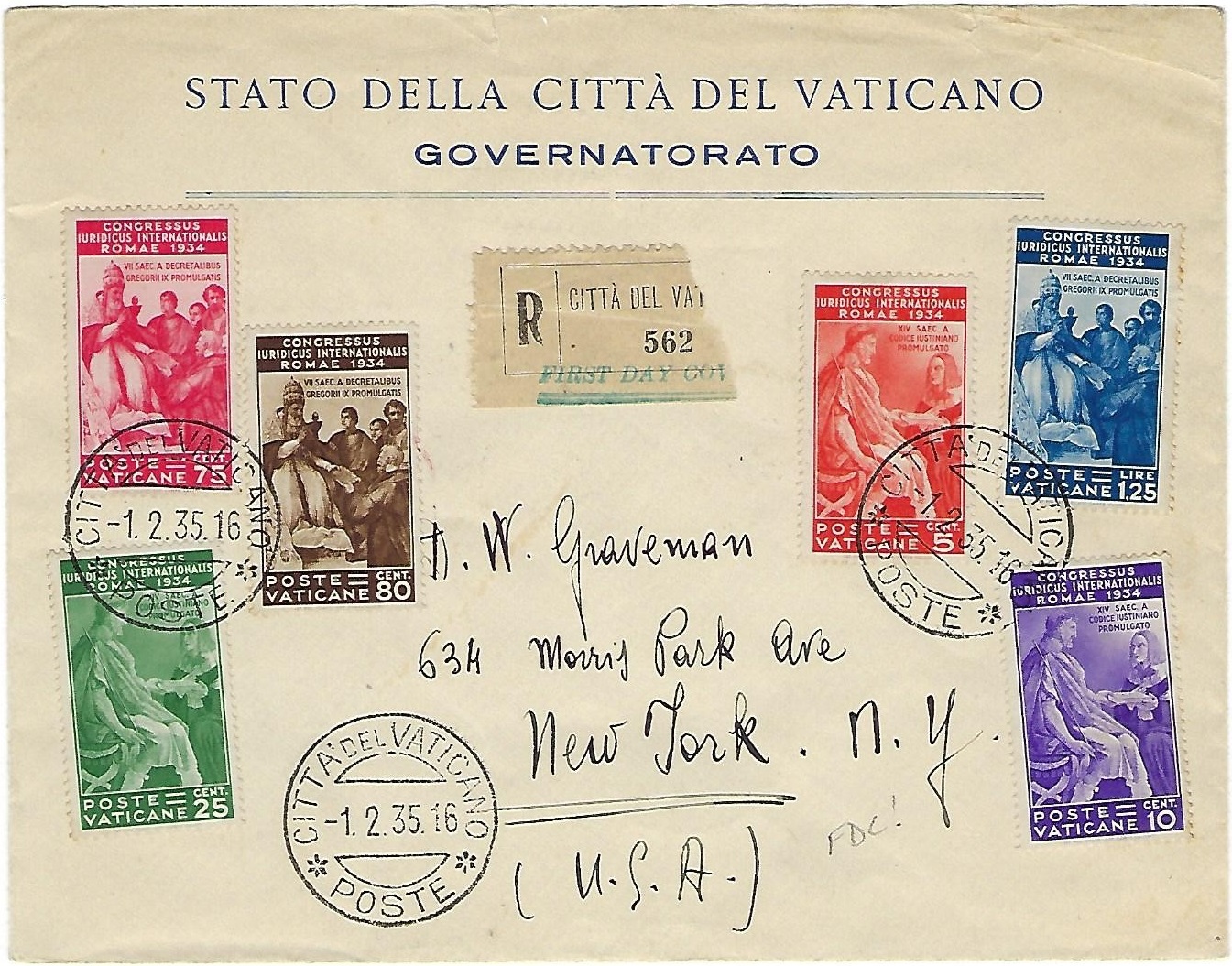









Catholic Press Conference
To mark the International Catholic Press Conference assembled at the Vatican, a commemorative set of eight stamps was issued on June 22, 1936. The 5 and 50 centesimi values bear a symbolic design as their motif, a ringing bell and a flight of doves. This design represents the purpose of the Catholic Press, to conduct a good and pure press to spread peace throughout the world. The second symbolic design is the opened Evangile upon the facade of a church. This symbol on the 10 and 75 centesimi values represents the need for a Catholic Press. The third major design of the issue bears an effigy of St. John Bosco, who was the founder of the Salesian Religious Order established chiefly for the education of youth.
This young saint opened his eyes for the first time on August 18, 1815, in a hillside village known as Becchi, in Italy. His early years were passed as a shepherd with his parish priest as his first teacher. In later years John attended the Seminary of Chieri to become a priest. He was ordained by Archbishop Franzoni and assigned to the diocese of Turin. Upon visiting local jails he resolved to help save the juvenile delinquents. He actually started this work on the feast of the Immaculate Conception, in 1841. By 1846, his group consisted of more than 400 wayward lads learning the correct way of life. In 1868, with fifty-odd priests who had aided him, John Bosco formed the Salesian Order. Upon his death on June 9, 1868, the order had grown to include the caring for 130,000 children in 250 houses throughout the world.
For his work and saintly life young Bosco was declared Venerable on July 24, 1907, by Pius X. On June 2, 1929, he was declared Blessed then solemnly canonized by the same Pope, Pius XI on November 28, 1933.
The second saint to be depicted on the stamps of this issue is the patron saint of the Catholic Press, St. Francis of Sales. Francis was born to noble and pious parents on August 21, 1567, near Annecy. His father had planned a state career for this brilliant youth and sent him to Paris and Padua for his studies. Upon his return from Italy he renounced the career of government service and entered the priesthood to which he was ordained in 1593. When the Duke of Savoy decided to restore the Church in the Chablais, Francis volunteered for the task. Along with his cousin Louis as a companion, he proceeded to Le Chablais, where he met strong opposition. He was quick to overcome his foes and it is said that he succeeded in converting 72,000 Calvinists to Catholicism. In 1602, he was made a Bishop and assigned to the See of Geneva, by Pope Clement VIII. With the aid of St. Jane Frances de Chantel, he founded the Institute of the Visitation of the Blessed Virgin, in 1607. The main reason of this order was for the young girls and widows who physically could not endure the hardships of other religious communities. His death came on December 28, 1622, while visiting in France. Pope Alexander VII pronounced his Beatification in 1661, and his canonization four years later.
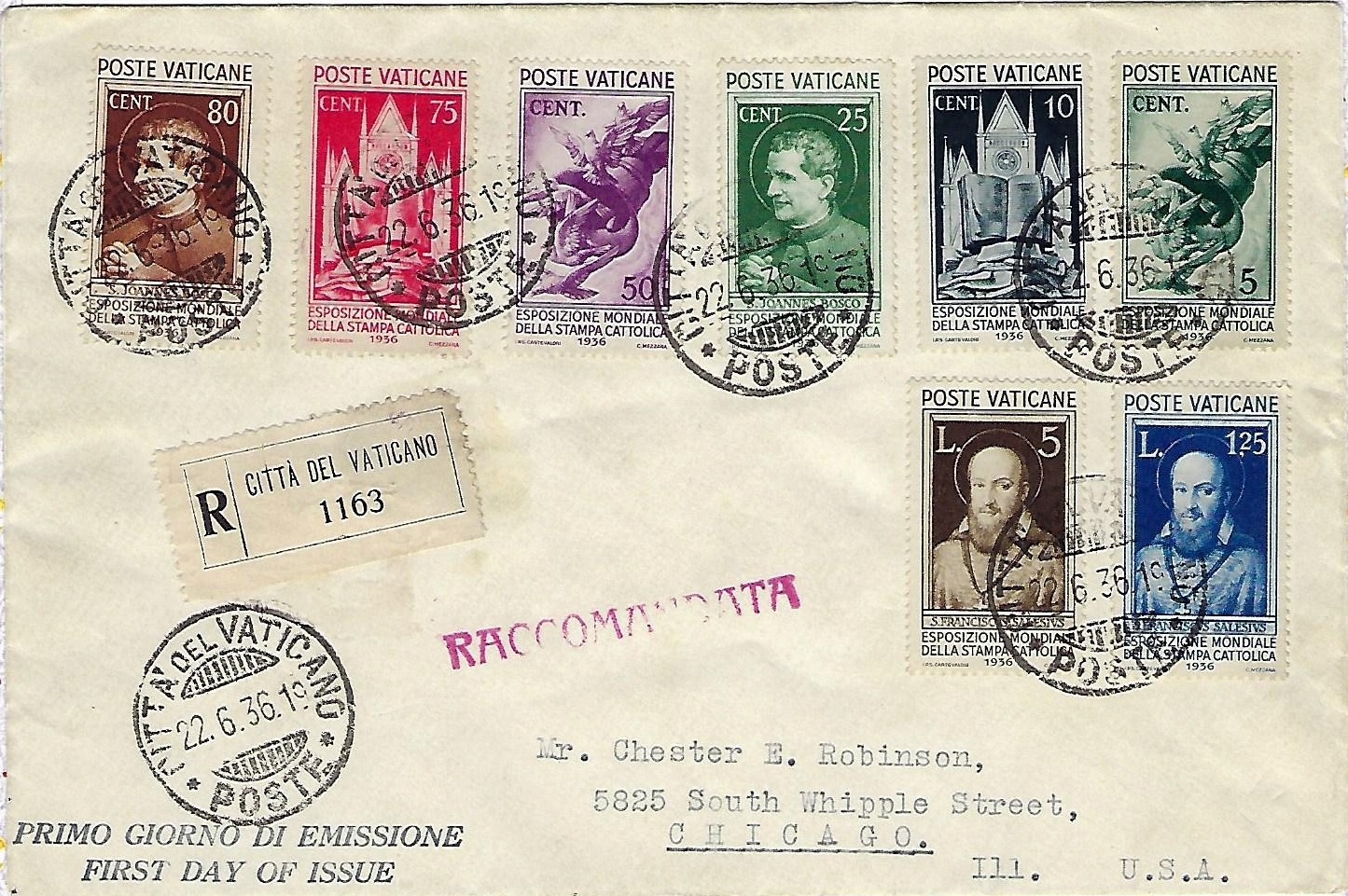







Archeological Congress
This set of commemorative stamps was released on October 12, 1938, to mark the gathering of scholars and students interested in the catacombs and their restoration. This issue of six stamps had two major designs, each common to three of the values.
The first design is a representation of the huge first crypt of the catacombs of St. Calyxtus on the Via Appia.
Saint Cecelia was a young and beautiful maiden of noble Roman birth who lived in the later part of the second century during one of the persecutions of the Christians. She was sentenced to death by suffocation for her refusal to renounce her faith. To carry out this cruel torture she was placed in a hot-air bath with the temperature rained 700 %. Though she remained in this torture chamber for a full day and night, she was unharmed. Finally, the emperor's lictor was sent to sever her head from her body. After the three blows allowed by law were struck, her head was only half severed and she remained fully conscious. The trembling lictor left her this way on the pavement of the bath, to die an agonizing death that was to last for another two days and nights. Death finally came to this young virgin saint in 177 A. D. and she went forth to join her Maker.
Her earthly remains were placed in the crypt of the Caecitti in the catacomb of St. Cultistus. In the year 817, by order of Pope Paschal I her body was exhumed and enshrined beneath the altar of the Church of Saint Cecelia in Trastevere.
In 1599, while the church was undergoing repairs, Cardinal Sfondrati came upon her body and it was found to be incorrupt. The sculptor Moderna was allowed to see her. He then created a lifesize statue of what he had seen.
The three high values of this set depict the remains of the Basilica of St. Petronilla.
St. Petronilla was a holy virgin who lived about the end of the first century. Unfortunately, the early christians did not compile long writings and we do not know the full story of her life. It is said that she was the daughter of St. Peter, though this has never been proven. We know from the Gospel that St. Peter was married before his apostleship and his wife had suffered martyrdom for her faith. Another account states that she was a relative of Christi Flavis. This theory has been claimed true with the final proof shown to be her burial in the Catacomb of Flavian Domitilla. Though there has never been actual proof brought forward for either of these alleged stories of St. Petronilla, they are generally accepted stories past through the ages.
We are certain however that she was a martyr for her faith from inscriptions found during the excavations of the tomb of St. Domitilla. The excavations have also revealed that an ancient basilica was erected over the tombs of Sts. Petronilla, Narveus, and Achilleus, and bore her name. During the Pontificate of Paul I, the marble sarcophagus containing her remains was transferred to St. Peter's Basilica. After the rebuilding of the basilica, her remains again were moved to an altar dedicated to her at the right side aisle of St. Peter's.








Interregnum Issue of 1939








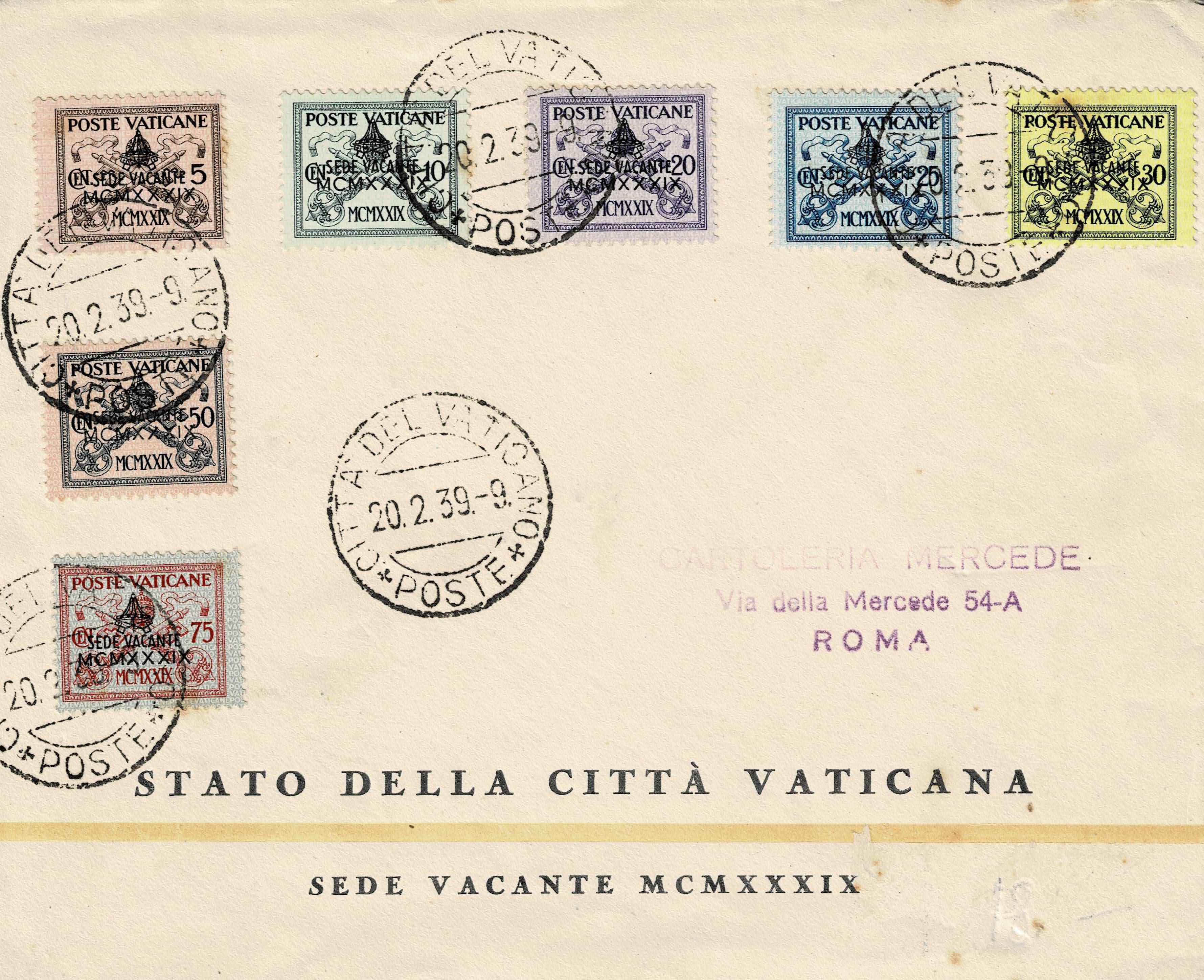




Coronation of Pope Pius XII
On June 12, 1939, a set of four stamps was placed on sale to commemorate the coronation of the 262nd Bishop of Rome, Pope Pius XII.
It was March 12, 1939, and crowd of eighty-five thousand jammed the Basilica of St. Peter while another half million stood in the square outside. Countless millions throughout the world tuned their radios to the Pope's own radio station HJV to witness the coronation of a Pope, the first time in ninety-three years, since the Popes became voluntary prisoners of the Vatican following the fall of Rome.
The ceremonies began with the blowing of silver trumpets from the Dome of St. Peter's. A minute later the doors of the basilica opened and a cross-bearer appeared. This was the beginning of a procession of uniformed guards and knights, bishops and cardinals, diplomats and representatives of forty countries, princes and members of the Papal Court. Pope Pius XII was borne on a portable throne following this procession bestowing his blessings upon the crowd as he passed by. The procession halted at the main altar over the tomb of the first Pope. The Pope then descended from his portable throne and seated himself on the Papal Throne near the altar. The cardinals paid their obedience to their new Pontiff after which Pius XII began his Coronation Mass.
After the colorful Coronation Mass was concluded the procession reformed and escorted the Holy Father to the balcony overlooking the square where the actual crowning took place (this scene is depicted on the stamps). The new Pope gave his blessing to Rome and to the world. The Pope once again ascended the portable throne to be carried back to the Vatican. The five-hour ceremonies marking the coronation of one of the greatest Popes of Church history had come to a close.

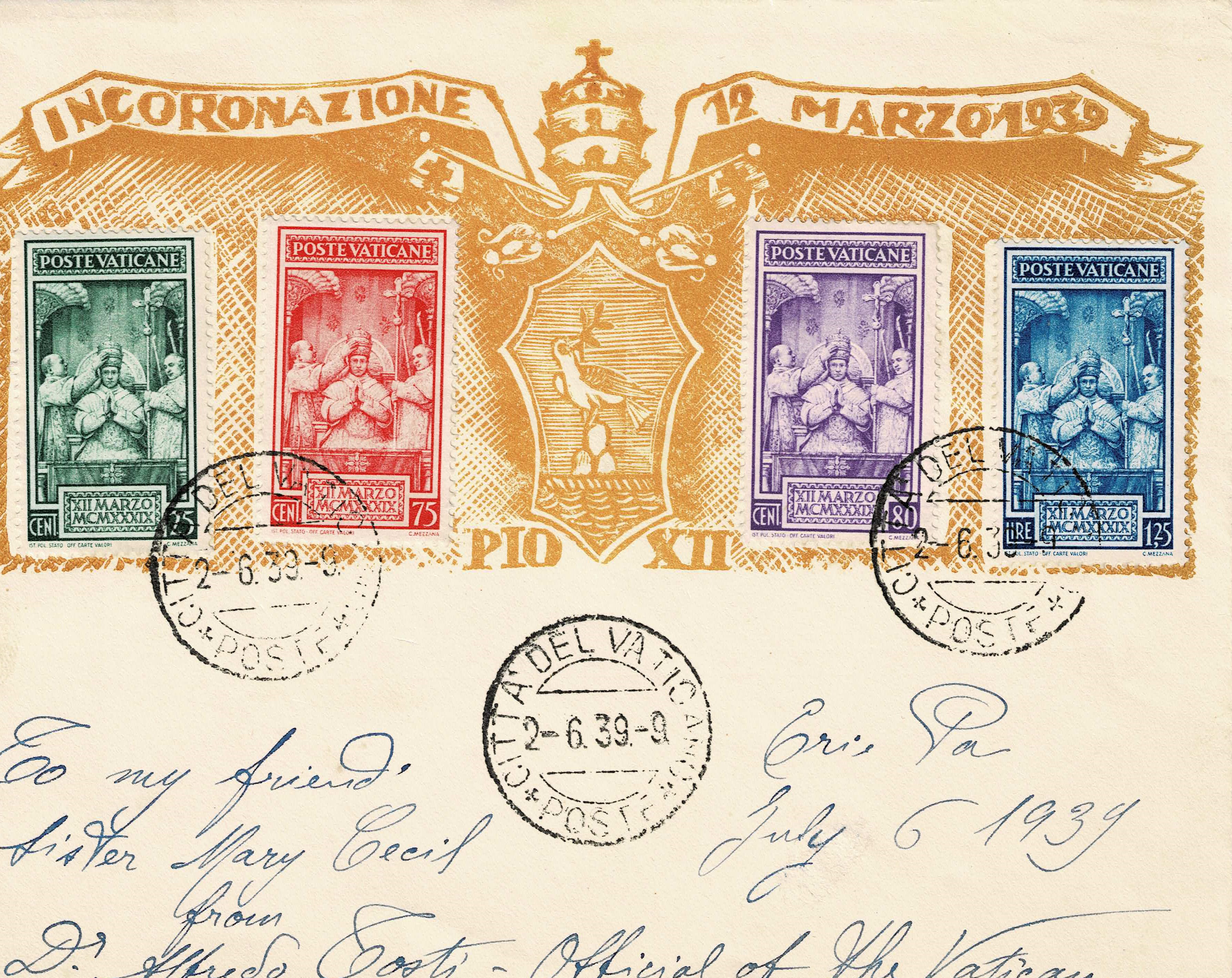





Pope Pius XII
On March 12, 1940, the first anniversary of the Coronation of Pope Pius XII, the first regular issue depicting the new Pontiff was placed on sale. The five values of the series depicted his coat-of-arms on the five centesimo stamp and a likeness of Pius XII on the 1, 1.25, 2, and 2.75 lire stamps. This set was issued to replace the corresponding values of the definitives of 1933, portraying the deceased Pontiff, Pius XI and his coat-of-arms.
The reigning Pope first entered this world on March 2, 1876, in Ponte, a suburb of the City of Rome. He was baptized Eugenio Maria Giuseppe Giovanni Pacelli. His education started in a public school attended by nuns. Even in his early youth he wore simple black clothing to look as much like a priest as possible. He started his service to God about the age of ten, when he offered his services as an altar boy to serve the priest faithfully at daybreak to offer the Holy Sacrifice of the Mass.
After attending preparatory school, young Eugenio attended the Capranica Seminary to start his training for the priesthood. Due to his bad health he could not endure the hardship of community life and at the end of a year was forced to leave the seminary. Because he possessed a brilliant mind and exceptional qualities that the services of the Church needed, he was granted the rare privilege of living at home and attending the Pontifical Gregorian University to complete his studies for the priesthood.
A boyhood wish was fulfilled in 1899. Eugenio Pacelli at the age of 24 became Father Pacelli, and celebrated his first Mass in the Church of Santa Maria in Vallicella at the tomb of St. Philip Neri, Apostle of Rome.
His role of parish priest was not to endure for long. He was appointed to the Secretariat of State as an apprentice and substitute professor of law at the Roman Seminary. A short time later Father Pacelli was appointed to the Congregation of Extraordinary Ecclesiastical Affairs as the titular professor of Canon Law. At the beginning of the Pontificate of Benedict XV, the now Monsignor Pacelli was appointed Secretary of the Congregation of Extraordinary Ecclesiastical Affairs.
On April 23, 1917, Benedict XV consecrated Mons. Pacelli as Archbishop of Sardia and appointed him as Papal Nuncio to Bavaria. During his tour as Nuncio, he did all he could to aid Pope Benedict's urgings for peace but his pleas fell on deaf ears.
For his excellent record as a diplomat, Archbishop Pacelli was named as the first Papal Nuncio to the new German Republic in 1925. While serving as Nuncio in Berlin he concluded concordats with two of the German States, Prussia and Bavaria and had started similar negotiations with Wurttemberg and Baden.
In 1929, Archbishop Pacelli was called to Rome to receive the Red Hat of the Cardinal. His title was bestowed upon him in the Basilica of Saints John and Paul in Rome.
In 1930, Cardinal Gasparri resigned as Secretary of State and Pope Pius XI appointed Cardinal Pacelli to this important post. A month after his appointment as Secretary of State, Cardinal Pacelli was made the archpriest of St. Peter's Basilica to fill the vacancy left by the death of the former archpriest, Cardinal Merry del Val. The last of his important roles before being elected Pope Pius XII was bestowed upon him in 1934, Cardinal Camerlengo of the Apostolic Chamber. On March 2, 1939, Cardinal Pacelli was elected to succeed Pius XI and he was solemnly coronated ten days later as Pope Pius XII, 261st successor of St. Peter.
On March 5, 1945, a set of ten stamps was released to replace the ordinary set then in use. In reality, it was simply an enlarged set of this issue with the two special delivery stamps showing the Vatican City State bearing new values to conform to the new postal rates:








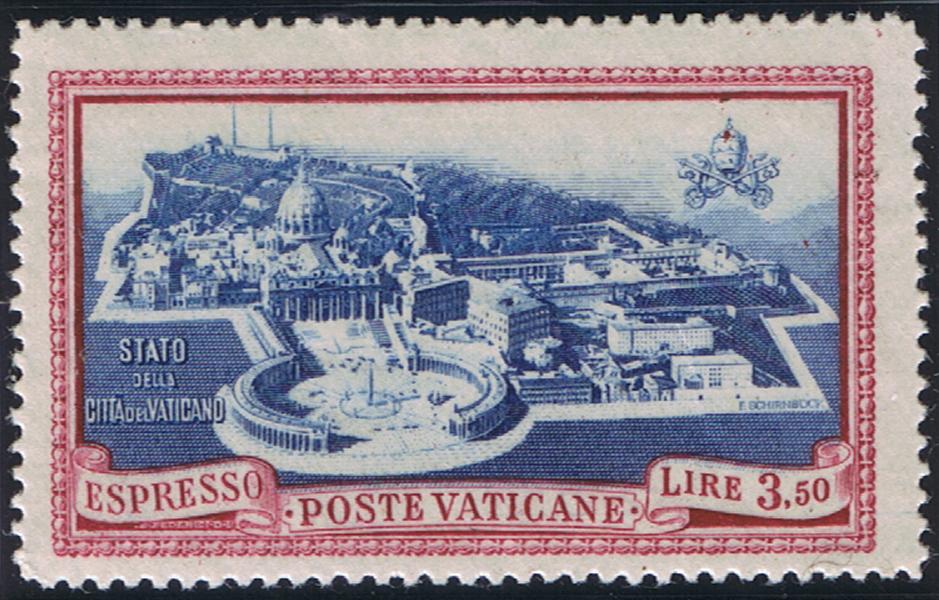









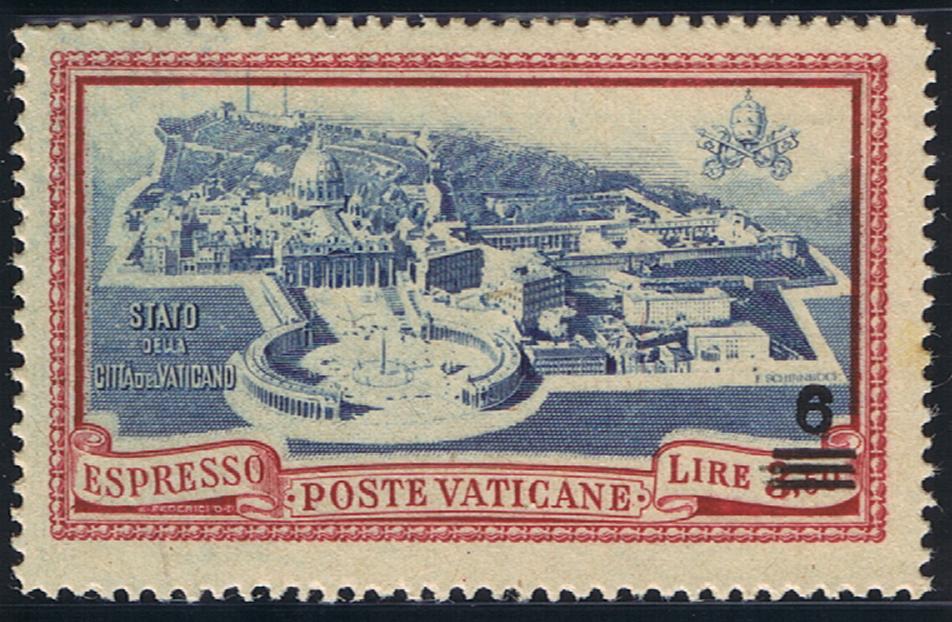






Prisoner of War Series
On September 1, 1942. Vatican City released a set of stamps depicting the Compassionate Christ looking on the multitudes. The set consisted of three values, 25 and 80 centesimi and 1.25 lire, all having the same design. The set was to publicize the efforts of Pope Pius XII on behalf of the Prisoners of War.
When all efforts for peace had failed and World War II had begun, Pope Pius XII established the Bureau of Information on War Prisoners and placed it under the jurisdiction of the Secretary of State. A volunteer staff composed of 150 priests, nuns, and laymen offered their services to this cause. Representatives of the Holy See in all countries participating in the war were instructed to gather the names and addresses of all prisoners of war that were possible and forward them to the Vatican. This information was then transmitted to the countries of the prisoners' origin. Many times the only information received about the prisoners of war was through the Vatican offices. Hundreds of inquiries were received daily by anxious relatives trying to locate their missing kin. As the war progressed, the work of the Bureau of Information on War Prisoners increased to new heights, forcing it to move to much larger quarters. In the first four years alone the Vatican had located more than forty thousand missing men in arms and forwarded this information to their homes. Throughout the war the Vatican strived to care for the wounded prisoners of war in the prison camps and aided those who escaped to neutral countries. For the duration of the war, Pius XII was constantly pleading with the belligerents to exchange prisoners but it was to no avail. With his request going unheeded, the Rock of Peace continued his efforts to relieve the misery of those affected.
On February 14, 1944, a second issue of the Prisoner of War stamps was placed on sale. The designs, values, and colors were identical with the first issue. The only identification being the inscription "MCMXLIII":












Episcopal Jubilee
In January of 1943, a set of four stamps was issued to mark the Silver Anniversary of the consecration of Eugenio Pacelli as Archbishop of Sardia. He was raised to the Episcopate on April 23, 1917, by Pope Benedict XV, in the Sistine Chapel. The elevation to the rank of Archbishop was not made by his immediate superior, Cardinal Gasparri, as it is usually done. This unusual procedure was carried out by the express wish of the Pope as he had come to hold the new Archbishop in high esteem for his aid in forthulating the peace proposals of the Holy See.
After this solemn ceremony of consecration to the Episcopal office in the presence of the entire Pacelli family, Pope Benedict presented the new Archbishop Pacelli with a beautifully bound and illuminated liturgical book containing the Canon of the Mass.
Archbishop Pacelli then was dispatched to serve as Papal Nucio to Bavaria. While serving as nuncio, he concluded several important concordats with various German States. When Germany became a republic in 1925, Archbishop Pacelli was appointed to serve as the first Papal Nuncio to Berlin.
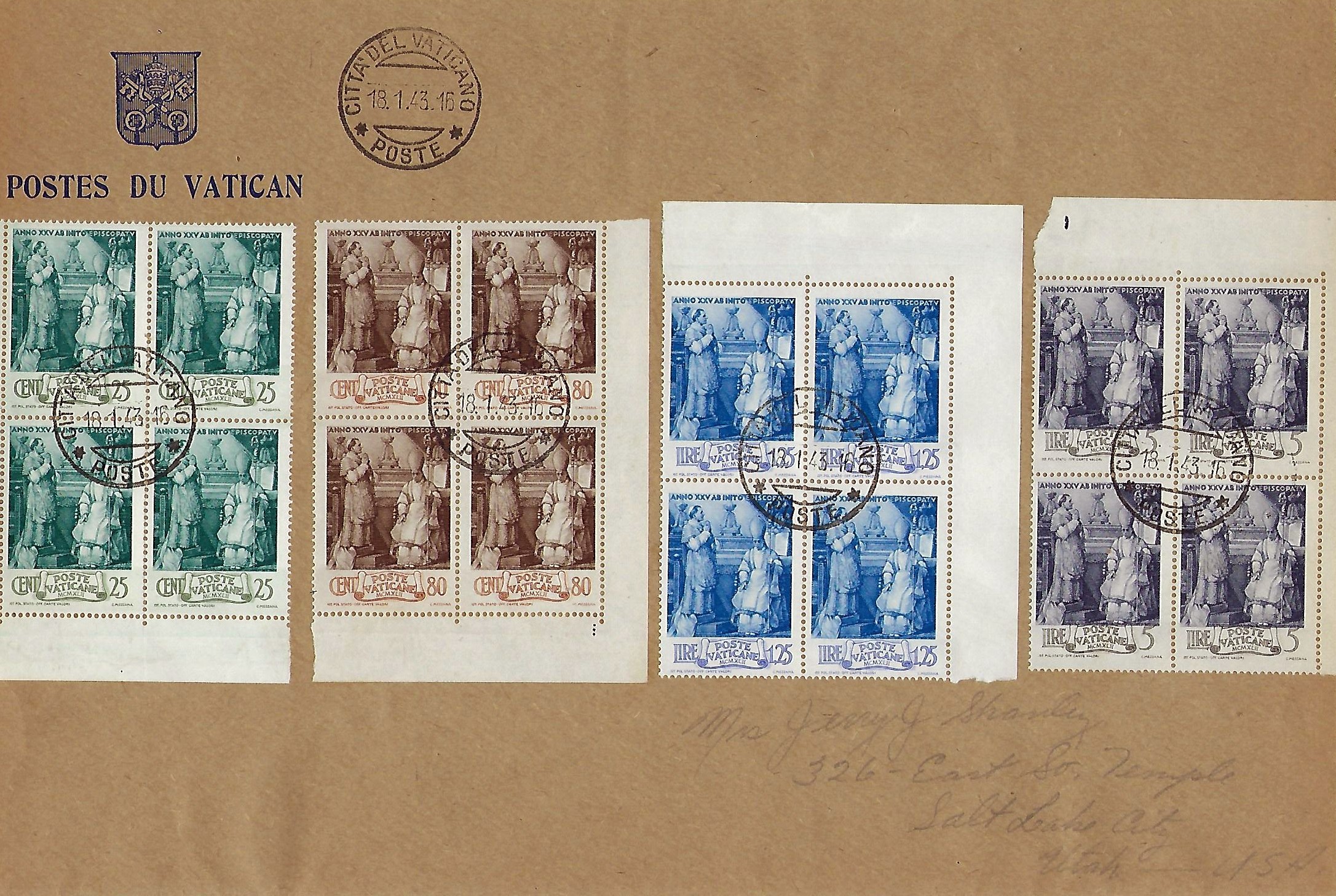
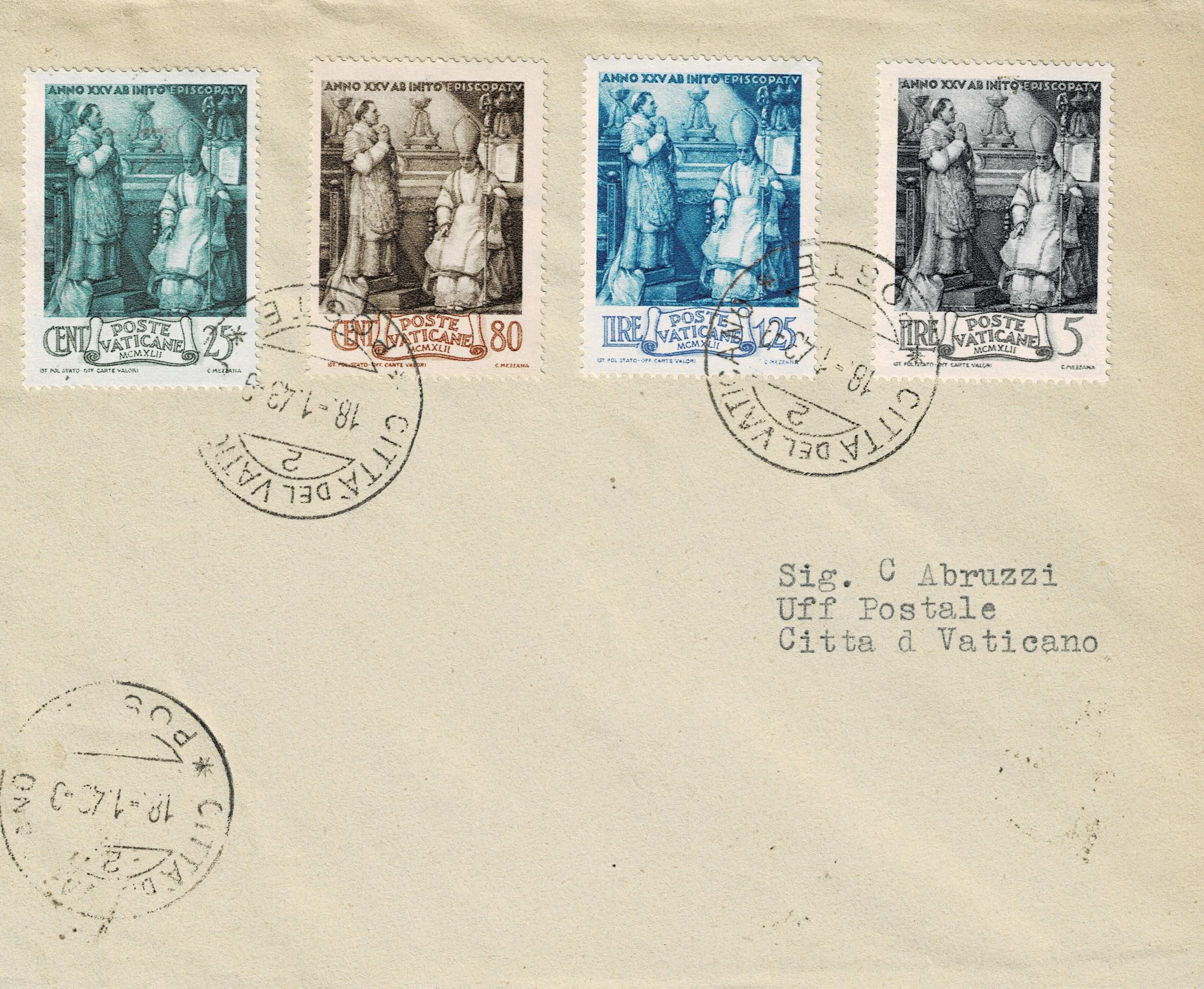



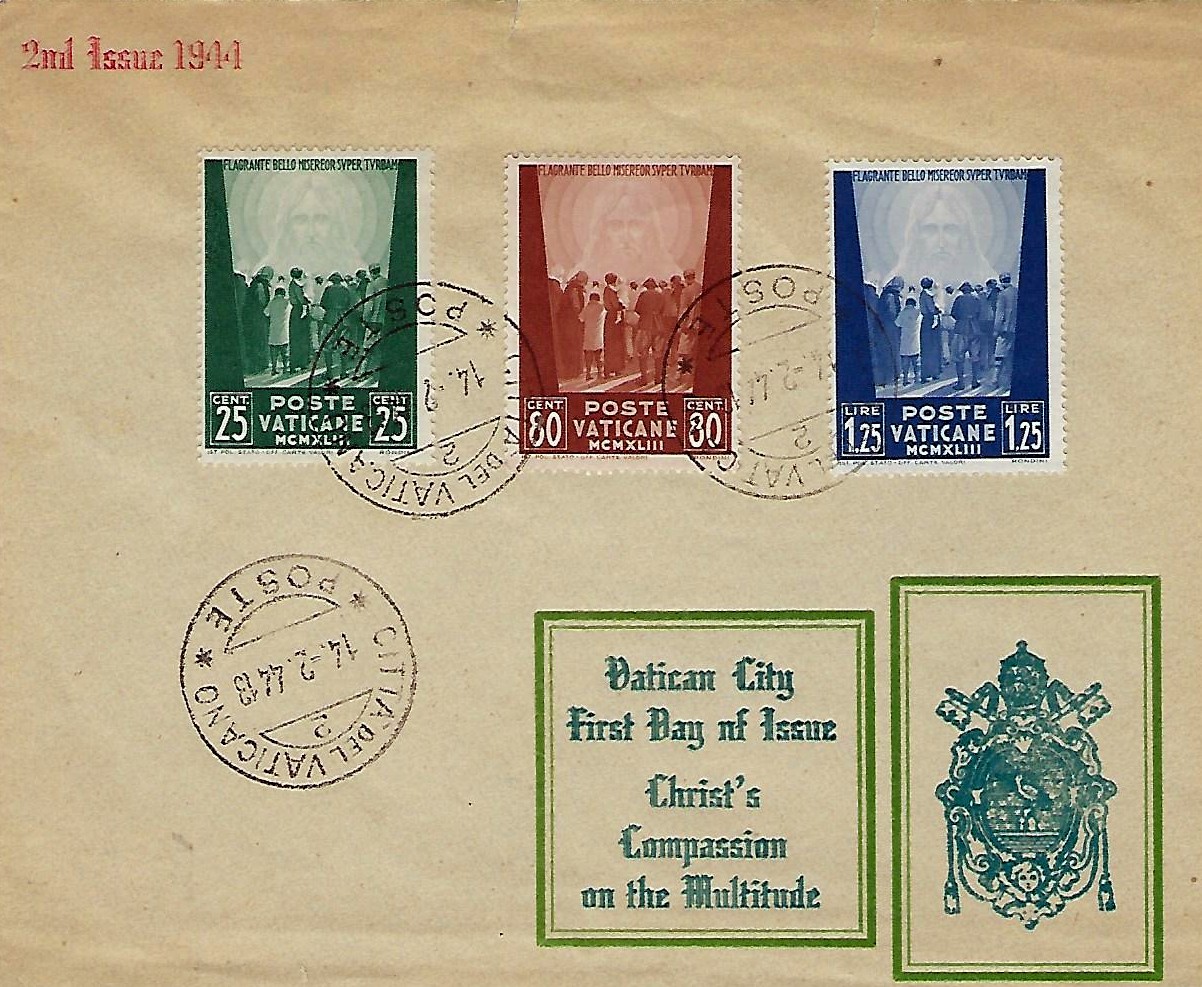




Pontifical Academy Issue
In 1944, a set of four stamps was released to mark the fourth centenary of the establishment of the Pontifical Academy of Virtuosi at the Pantheon. The academy was formed by Pope Paul III in 1542, to promote Christian art, painting, sculpture, and architecture. Membership is by invitation only and granted to men of outstanding achievements in the fields of the Christian arts and sciences.
The Painter Prince, Raffaello Sanzio, more commonly known as Raphael is portrayed on the twenty-five centesimi value. Raphael was born in Urbino, Italy in 1483. He is recognized as one of the greatest religious painters of the world and the supreme painter of the Madonna. In his early years he studied with Perugino. In 1504, he journeyed to Florence to profit from the work of Leonardo da Vinci and Michelangelo. Four years later he went to Rome and executed the matchless frescoes that adorn "Raphael's Rooms" in the Vatican. In 1509, Pope Julius II appointed him Writer of the Apostolic Briefs. Upon the death of Bramante, Pope Leo X charged him with the task of supervising the reconstruction of St. Peter's Basilica. In 1515, further honors were paid him by his appointment as Prefect of Antiquities. Raphael's short life of thirty-seven, years came to an end in Rome in 1520.
Antonio da Sangallo was the famed architect of the New Walls of Rome and the Santo Spirito Gate. The Gate was incomplete when young Sangallo went to his death in 1546. Another of his immortal works of architecture is the Palazzo Farnese, one of the finest structures in Rome.
Another painter, Carlo Maratta, is depicted on the third stamp of this issue. Maratta was responsible for restoring the rooms of the Vatican Palace. During his pontificate, Pope Alexander VII entrusted him with the paintings that were to become great masterpieces and one of his crowning achievements, "The Visitation of St. Elizabeth" and the "Flight to Egypt" for the Chigi Chapel of the Cathedral of Siena.
The last denomination of this set portrays Antonio Canova (1757-1821) . He was the creator of the new Italian statuary art. Among his great monuments, those to Pope Clement XIII and Pope Clement XIV found in the Basilica of St. Peter, are among his finest.
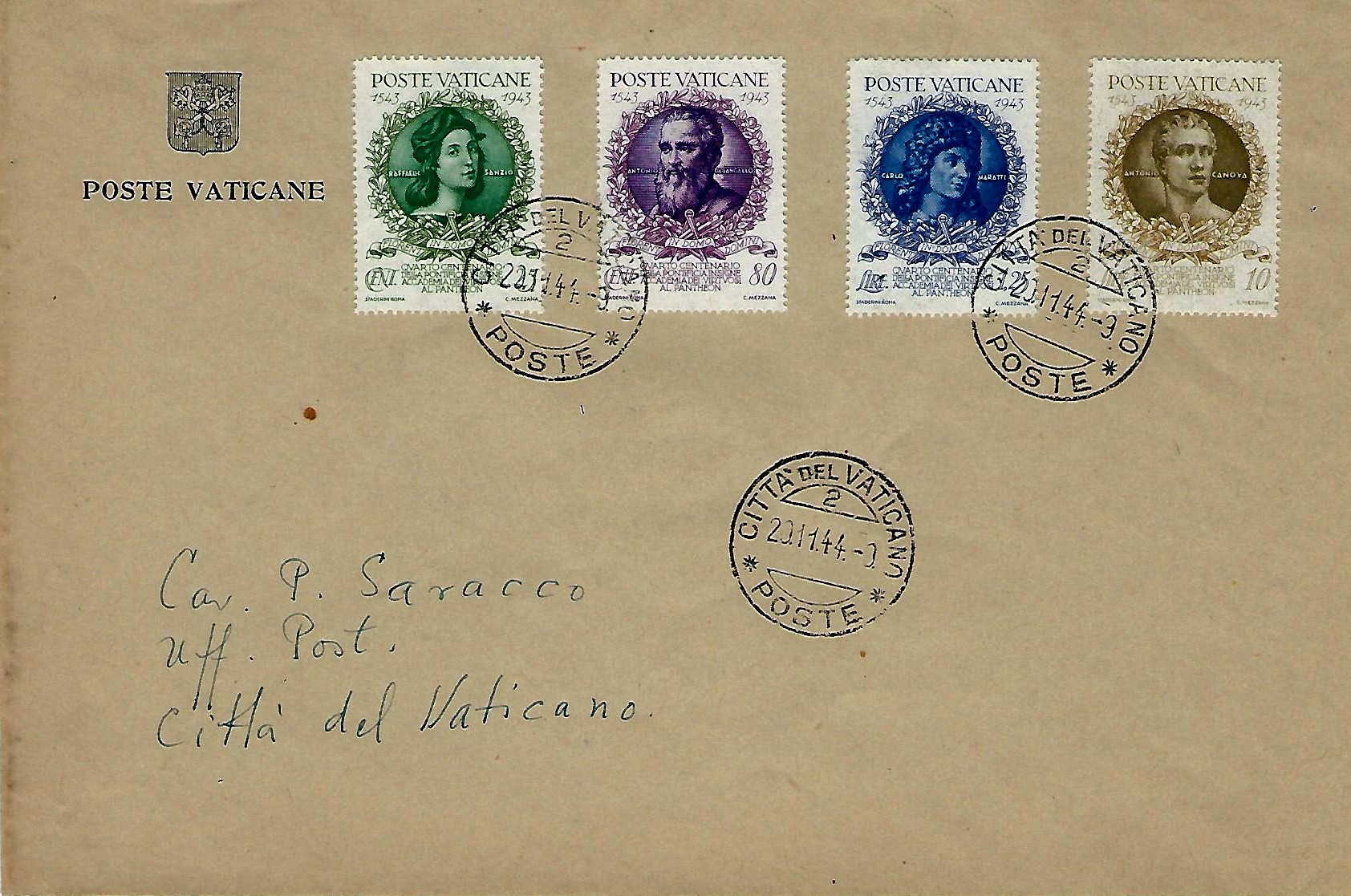














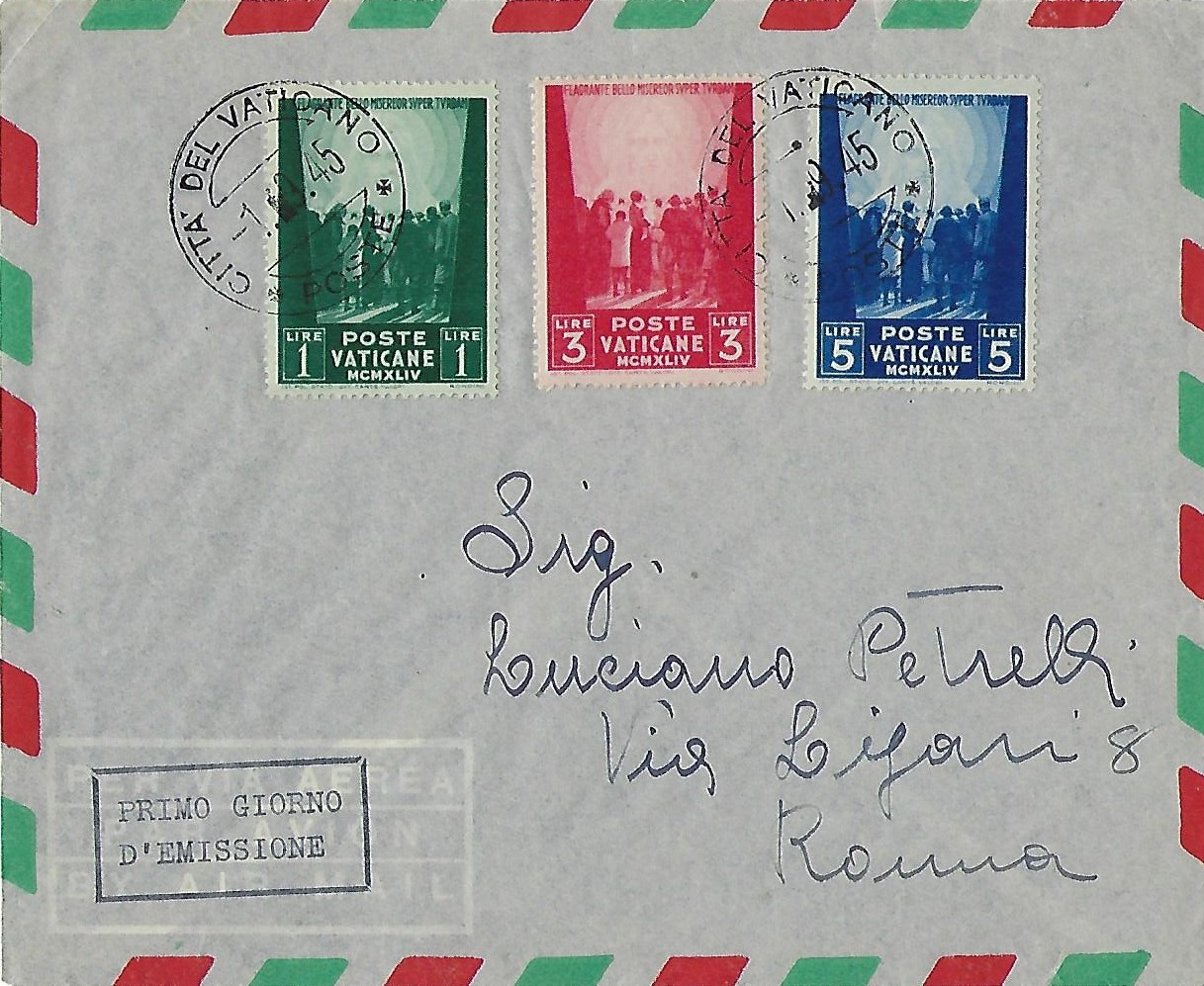










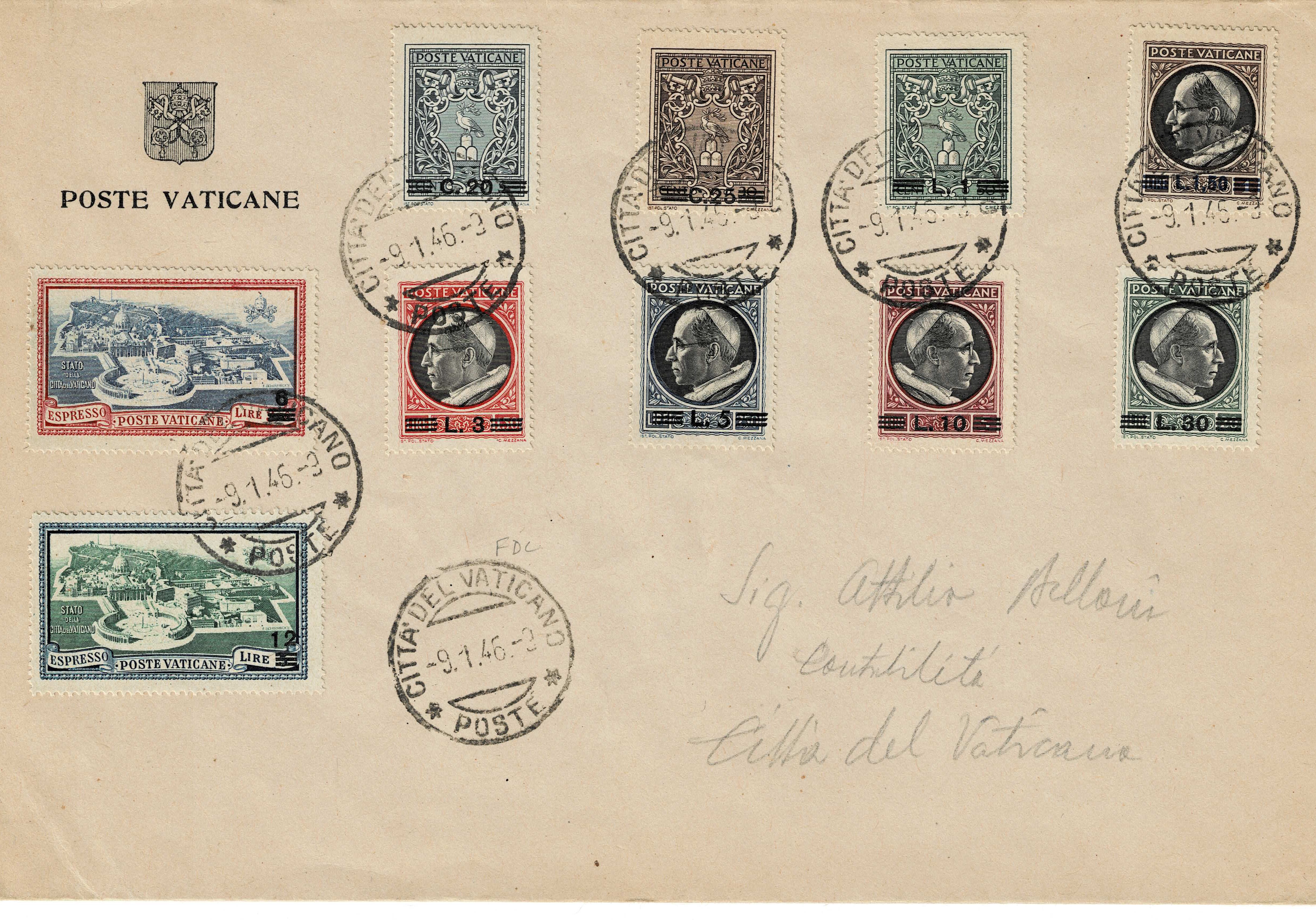












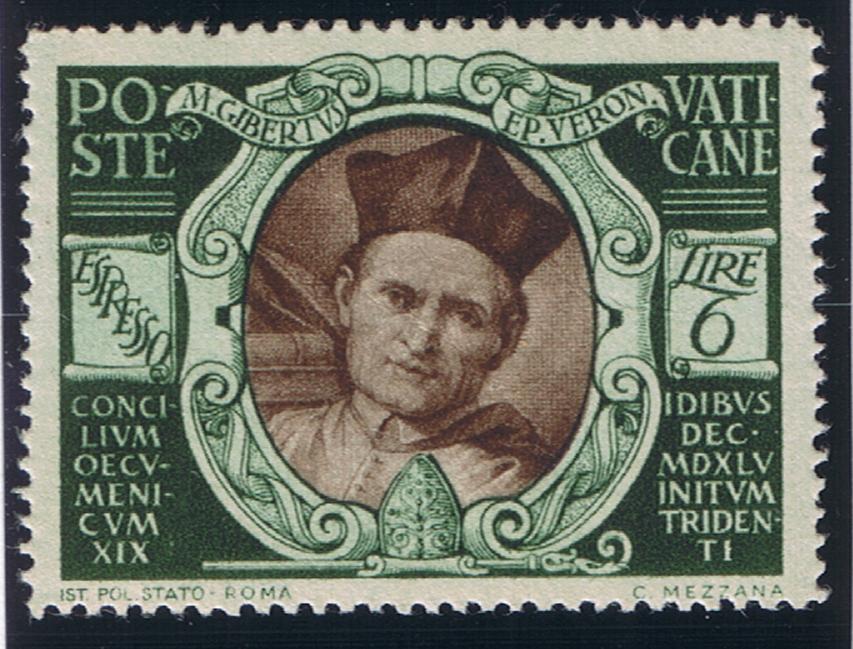
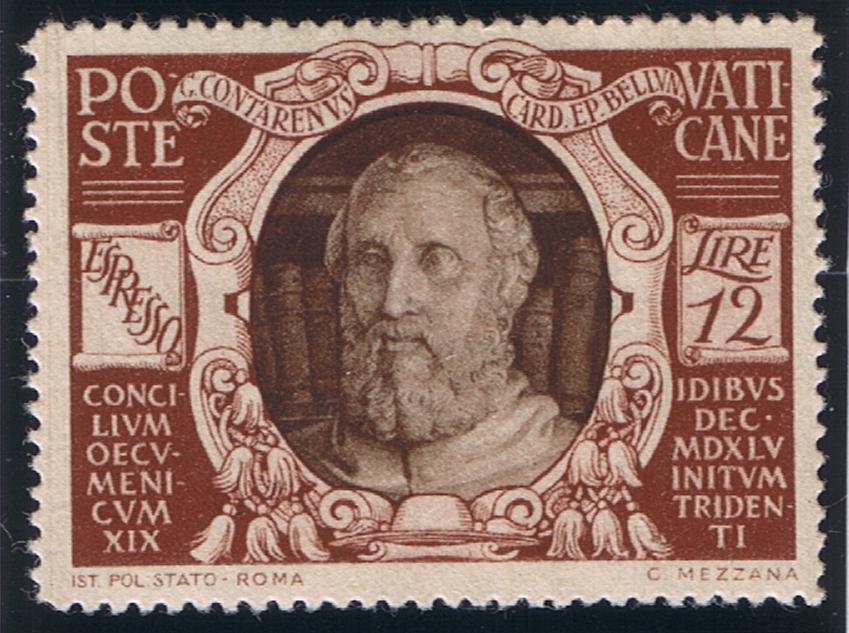
Council of Trent
On February 20, 1946, the Vatican released a set of stamps to commemorate the fourth centenary of the Council of Trent. In reality, although this issue had a commemorative theme, it was a new set of definitives to provide values badly needed by the Vatican Postal Administration. The Council of Trent convened on December 13, 1545, by order of Pope Paul III to issue a definitive declaration of the Doctrines of the Church in answer to the Protestant heresies and to reform the inner life of the Church by removing the abuses that had developed in it. The sessions of the council defended and made clear fundamental truths of Christianity including such controversial subjects as: the authority of the Bible, original sin, the Mass, and the Sacraments especially Matrimony and Holy Orders. So complete was the work of this council that it extended for almost a generation, finally coming to an end on December 4, 1563. The influence of the Council of Trent was so great that its effects on the religious and civil life can be traced to modern times. The personalities honored on the stamps of this set are not only those who played an important role in the council, but those who contributed towards its preparation as well.














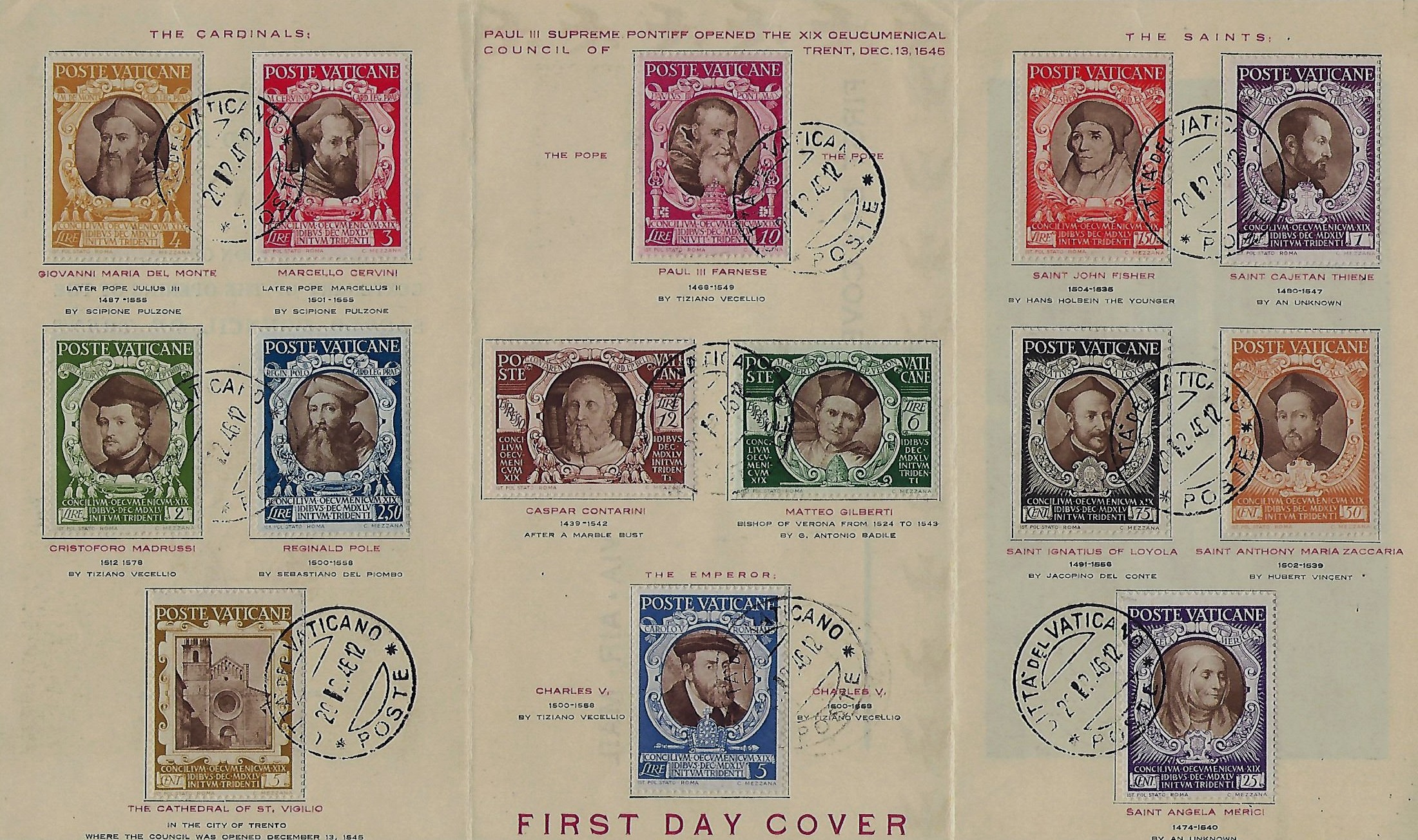
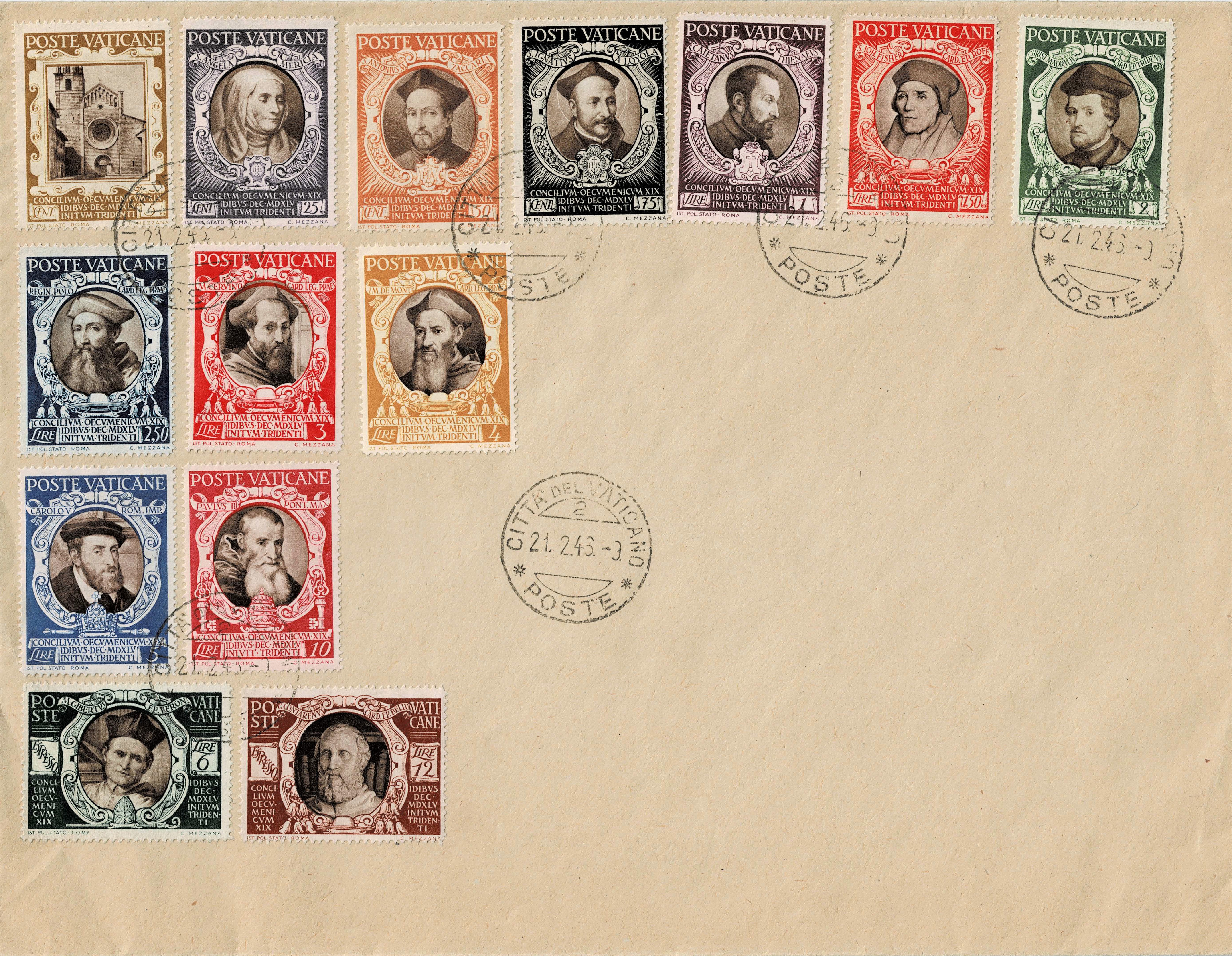










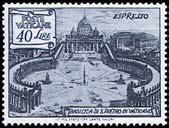


The Basilica Issue
On March 7, 1949, a new set of stamps for ordinary use was placed on sale for the first time. Each of these designs depicts one of the major basilicas and titular churches of Rome. In reality, this series of stamps was the forerunner of the Holy Year, as it publicized the major basilicas to be visited by the Holy Year pilgrims. The first stamp of the series depicts the Basilica of St. Agnes. This church originally was built over the tomb of this young martyr by the Emperor Constantine. During the Pontificate of Pope Symachus (498-514) the church was restored. A complete rebuilding of taken by. Pope Honorius I, during his reign (625-640).
On St. Agnes' Day (January 21st) two lambs are placed on the altar and blessed. The lambs then are cared for by nuns until Easter when their wool is shorn to make the "Pallia." This again is blessed and worn by the Pope. The Pallia then is sent to new archbishops as a sign that they are in union with Rome and share in the plentitude of the episcopal office.
The second basilica portrayed is that of St. Clement, the third Pope. The original basilica dates back to the fourth century when this church was erected on the foundations of the house of Clement. It was destroyed during one of the many sackings of Rome. In the year 1108, Pope Pascal II filled in the remains of the church and built a new edifice on its ruins, using many of the decorations from the original basilica. On the 8 lire stamp the Church of St. Prassede is shown. The present basilica was erected in 822, by Pope Pascal II. During the Pontificate of Pope Nicholas V it was restored, as well as in the years 1832 and 1869. One of the outstanding features of the church is the column at which Christ was scourged. In the crypt of this church, noted for its mosaics, are the remains of Saints Prassede and Prudentiana.
The Church of St. Mary of Cosmedin was built on the site of an ancient Roman temple. It was constructed in the sixth century for the Greeks living in the area and originally named St. Maria in Schola Greca. In 782, it was reconstructed by Pope Adrian I who gave it the name of St. Mary of Cosmedin. The word "Cosmedin" comes from the Greek meaning, ornament. Two versions for this word have been given, the first states that it means the church was dedicated to Our Lady of Adornment, while the second version claims it refers the adornment of the church it-self.
The Church of the Holy Cross of Jerusalem (13 Lire stamp) was erected by the Empress Helena, the Mother of Constantine. She journeyed to the Holy Land to obtain relics of the Crucifixion and to build in Rome a shrine for those who were unable to make a pilgrimage to the land of Christ's Passion. Among the relics preserved in this basilica are: a portion of the True Cross, the inscription placed over the head of Christ on the first Good Friday, one of the nails that pierced His holy body, thorns from the crown of the Savior, and the finger Thomas placed in the side of Christ to affirm it truly was the Savior. The church was rebuilt and remodelled many times in past centuries so that it does not represent the original structure erected by the Empress Helena.
The. Church of St. Sebastian was named after a young Praetorian Guard officer of the reign of Dioceletian. He was accused of being a Christian and condemned to be shot to death by arrows. Miraculously he survived and returned to his duties where he confronted the emperor and reprimanded him for his cruelty to the Christians. He was again sentenced to death, this time to be beaten with clubs and his body to be thrown in the sewer. The corpse was recovered by a government official's wife, Lucina, and buried near a chapel where the bodies of St. Peter and St. Paul had been taken a few years before for safe keeping. A church was erected in the Middle Ages in honor of this soldier martyr and it is now one of the seven Pentitential Basilicas of Rome.
Another of the Basilicas erected by the Emperor Constantine is that of St. Lawrence outside-the-walls. It was rebuilt and enlarged during the reign of Pope Pelagius II. It was again remodeled by Pope Honorius III and changed extensively. On July 19, 1943, the basilica was hit by a bomb damaging the roof, walls, and pillars. The work of restoring this famous church again was undertaken. One of the notable additions is a marble monument to Pius XII for his efforts in removing the Eternal City from the list of military targets. The Basilica of St. Paul out-side-the-walls (35 Lire value) originally was built by Constantine to mark the grave of this Apostle. While Emperor Valentinian II reignea, he began a new church on this sacred ground. The structure finally was finished during the Pontificate of Pope Honorius. It was destroyed in the great fire of 1823. Immediately after the inferno ended, Pope Leo XII began the reconstruction of St. Paul's Basilica. It was finished during the reign of Pope Pius IX and solemnly consecrated in 1854. Tradition claims that the church also marks the spot where Peter and Paul parted to go to their martyrdom, Peter by crucifixion and. Paul by beheading.
The Basilica of St. Mary Major is the main basilica in Rome dedicated to the Mother of God. The Basilica was built by Pope Liberius (325-366) after a vision of the Holy Virgin appeared to him on the night of August 5, 352, and instructed him to build a church on the Esquine Hill on the spot where snow would be found in the morning. The basilica was erected and named St. Mary of the Snows. During the Pontificate of Pope Sixtus III, (432-440) the church was remodelled and dedicated to St. Mary, Mother of God.
This church, dedicated to the Blessed Virgin Mary, was the scene of the opening ceremonies of the Marian Year, on December 8, 1953. This special jubilee extends to December 8, 1954, the first centenary of the Dogma of the Immaculate Conception.
St. Peter's Basilica is portrayed on. the 40 lire special delivery stamp of this issue. The church was erected over the tomb of the first Vicar of Christ. As many of the ceremonies were held here, Popes of the early church erected a simple dwelling to house themselves and entourage overnight after the rites at the basilica. As time went on the simple dwelling assumed the proportions of a palace. In the year 1377, Pope Gregory XI returned to Rome from Avignon, France. Instead of taking residence at the Lateran Palace as his predecessors before their move to France, he chose to live alongside St. Peter's Basilica. This was the real beginning of the Vatican as we know it today. If it were not for the tomb of St. Peter, the Vatican City State would not be where it is today.
St. John Lateran, Cathedral Church of the Pope, was founded by Constantine and presented to Pope Sylvester I as his official residence. Subsequent Popes also resided here until the move of the Papacy to Avignon in 1307. Originally, the church was dedicated to the Holy Savior. In 898 it was destroyed by fire and a new edifice erected and dedicated to St. John the Baptist. Fire again ravaged the basilica in 1308. Again it was rebuilt by Pope Clement V. The following Popes extended and remodeled the church to such a degree that its original form no longer is recognizable. Among the sacred relics found in the Basilica of St. John Lateran are the heads of Saints Peter and Paul enshrined in the high altar, and a table taken from the catacombs that was used by St. Peter as an altar.
The Church of St. John Lateran not only is the Cathedral Church of the Popes, but also is the Mother and Head of all Churches, the Cathedral Church of Rome, and of the Catholic world. It has also been the scene of many ecclesiastical conclaves known as "The Councils of the Lateran."
The basilicas as represented on this series have been taken from old engravings and are not replicas of the churches as they exist today. This issue of stamps is completed by a 100 lire value portraying His Holiness, Pope Pius XII.
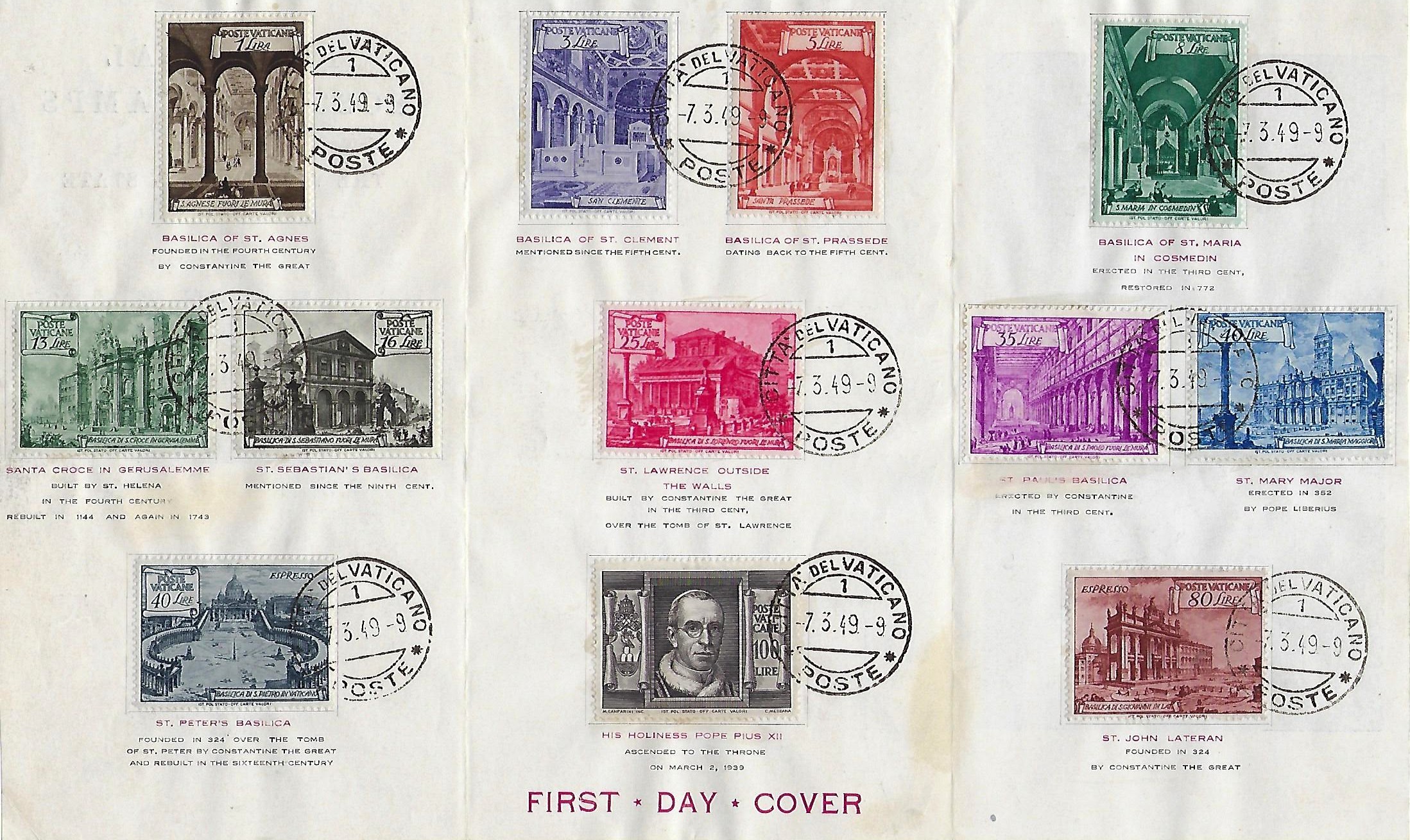
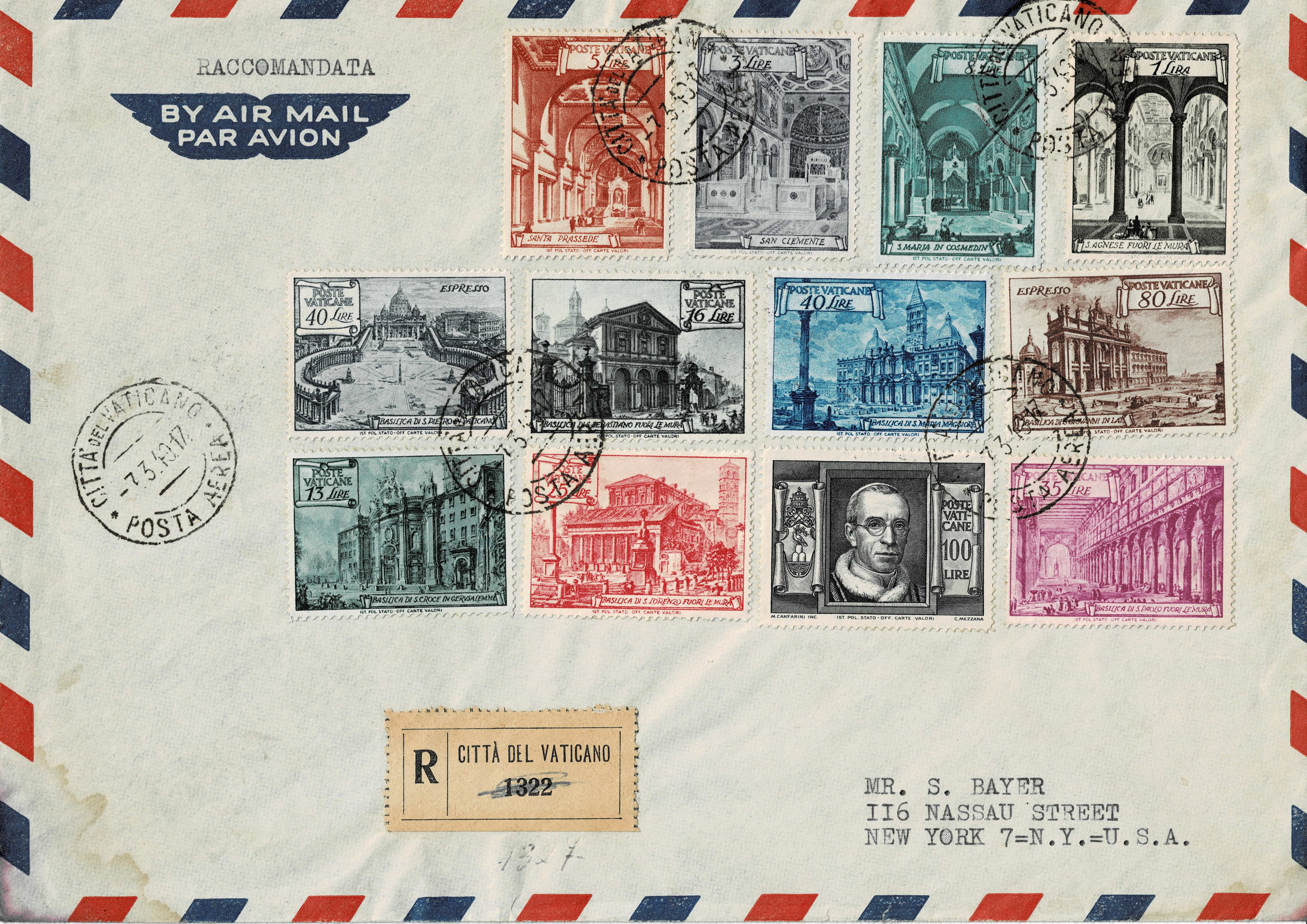








Holy Year of 1950
On May 26, 1949, Pope Pius XII proclaimed a Holy Year of Jubilee to begin on December 24, 1949, and extend until December 24, 1950. This was the twenty-fifth Jubilee since the first proclaimed by Pope Boniface VIII in 1300. The intentions of the Jubilee as mentioned by the Holy Father were:
1. The sanctification of souls through prayer, penance and loyalty to Christ and Church.
2. Activity for peace and the protection of holy places.
3. Defense of the Church against renewed attacks on her enemies, and prayers for the true Faith fos those in error and the godless.
4. The realization of social justice and works of charity for the lowly and needy.
To obtain the special Holy Year Indulgence the pilgrim was to go to Confession and Holy Communion, visit the four major basilicas of Rome at least once, and to pray for the Pope's intentions.
To publicize this special Jubilee, a set of eight stamps was issued on December 21, 1949. There were four major designs common to two values.
The 5 and 6 lire stamps reproduce a particular from the mural painting by Pietro Vannucci in the Sistine Chapel. It represents Christ giving the Keys to St. Peter, the first Pope. This presen-tation of the Keys to Heaven represents the power of the Pope to grant special indulgences for the Holy Year, among other things.
The 6 and 25 lire values depicts the four major basilicas of Rome, St. Paul outside-the-walls, St. Mary Major and St. John Lateran, (within the walls on the stamp) and St. Peter's in the Vatican. The special Holy Year Indulgence can be gained each time the pilgrim visits each of these basilicas once and recites the "Our Father," "Hail Mary," and the "Glory be to the Father" three times. They then must repeat each of these prayers once more for the intentions of the Holy Father, as well as the Creed. These are the only obligatory prayers stipulated in the Papal Bull promulgating the Holy Year.
The 8 and 30 lire denominations reproduce a painting found on the first pilaster of the right aisle of the Basilica of St. John Lateran. The painting depicts Pope Boniface promulgating the first Holy Year of Jubilee in the year 1300. Toward the end of the century many pilgrims, under the impression that the Pope granted a special indulgence every hundred years, assembled in Rome from all parts of Europe. This caught Pope Boniface by surprise. After searching the record he found no proof of this belief. Nevertheless he would not disappoint the faithful, and he decreed that the fullest pardon for all sins would be granted to those who visited the Basilicas of St. Peter and St. Paul. They must be fully penitent and confess their sins. This was not only decreed for the year 1300, but for each succeeding century. As time went on, the reigning Pontiffs shortened this period of waiting to fifty years and still later to every twenty-five years.
The opening of the Holy Door is depicted on the 10 and 60 lire stamps. Each of the four major basilicas has a Holy Door. Two weeks before the Jubilee begins, the Pope appoints Cardinal Legates to open these Holy Doors; the Cardinal Deacon presides at the cere-monies in St. Paul's, while the Cardinal Archpriests of St. John Lateran's and St. Mary Major's open the Door in their respective churches. The opening of these Holy Doors commences on December 21st, followed by the opening of the others on December 22nd and 23rd. On December 24th, the Holy Father officially opens the Holy Door of St. Peter's to begin the Jubilee. Christmas Eve is chosen as the beginning of the Holy Year because the coming of Christ on that day signified the Gates of Heaven were opening for all who died in the state of grace.





Palatine Guard
To mark the hundredth anniversary of the Palatine Guard of Honor of His Holiness, a set of three commemoratives was released on September 12, 1950. The Palatine Guards were established on December 14, 1850, by Pope Pius IX from two previously existing bodies of militia. Ordinarily their duties consist of standing guard at Papal processions and solemn functions. Unlike the Swiss Guards, they are not full-time professional soldiers, and receive no money for their services other than a small allowance for their uniforms.
The uniforms consist of a high military hat known as a shako, which falls over the nape of the neck, with a slender red plume in the front. The trousers are dark blue, worn with tunics trimmed in crimson and gold. The sword belts, rifle straps, and cartridge cases are all in white. The weapons of the Palatine Guard are old model rifles and daggers of nickel. During the German occupation of Rome, these part-time guards were summoned to full-time duty. Small detachments were placed in all the buildings under the jurisdiction of Vatican City throughout Greater Rome. In the Vatican proper, a company of more than 150 Palatine Guards were stationed. All through the occupation the guards faithfully carried out their task of protecting the properties of the Holy See. Even when the bombs fell on the Vatican on November 5, 1943, the two guards stationed near the damaged area refused to leave their post. With the end of the war the Palatine Guards of Honor of His Holiness once again returned to part-time duty.




Dogma of the Assumption
To Commemorate the Declaration of the Dogma of the Assumption, the Vatican Postal Administration released a set of two stamps on May 8, 1851. A Dogma is the proclaiming of a certain truth by the Pope, and it is to be accepted and believed by all of the Catholic Church. A Dogma never is declared on the spur of the moment. Many months and more often years are devoted to research and study of the article of faith. Theologians and Cardinals examine the Holy Scriptures and all available documents to ascertain the truth of the belief. Both the pros and cons are heard and the evidence carefully weighed. If, after this long study, the article of faith has been proven a fact it is defined and proclaimed by the reigning Pontiff as an infallible Dogma and must be accepted by the faithful. The belief that was defined and promulgated by Pope Pius XII in 1950, was the Assumption: the belief that upon the death of Mary, the Mother of God, her body as well as her soul rose to heaven on a cloud surrounded by Angels. The Blessed Virgin was the only mortal to be brought to heaven in this manner.






Beatification of Pius X
On June 3, 1951, a crowd of 300,000 jammed St. Peter's Square to witness the Beatification of Pope Pius X. This is the first time since 1672 that a Vicar of Christ (Pius V) was elevated to this honor and the eighth time the title of "Blessed" was conferred upon a Pope in the History of the Church.
Pope Pius X (Guiseppe Sarto) was born of humble parents at Riese, near Venice in 1835. Before his election to the Chair of Peter, he served the Mother Church as a small village priest, cathedral canon, and seminary professor. He was consecrated as Bishop of Mantua on November 16, 1884, at the Church of St. Apollinaris in Rome. On June 12, 1893, he was elevated to the Cardinalate with four other prelates. On August 4, 1903, he was elected to succeed Pope Leo XII. The crowning achievement of the eleven year Pontificate of Pius X was his Syllabus issued in 1907, condemning works taken by radical writers on modernization of religion. Among the phases of religion the modernists criticized were matters of Christian belief, Biblical criticism, theology, and church discipline. The reign of Pope Pius X also saw the separation of Church and State in France and Portugal. This saintly Pope, also started the inauguration of codification of Canon Law, which was left unfinished at his death. The honor of decreeing the completed codification fell to his successor, Benedict XV. On August 20, 1914, the holy soul of Pius X left this world to join his Heavenly Maker.
The Beatification of June 3rd was the rite of conferring the title of "Blessed" upon Pope Pius X, but what does Beatification mean? By Beatification is meant that a holy person, after a long and careful study of his or her acts, and entire life is believed to be in Heaven. This study of the life of the person is begun in their home diocese and ends with the solemn ceremony in St. Peter's. Between these two places all persons acquainted with the person are questioned as to his or her acts. All writings of the tenative Blessed are sent a Tribunal of the Sacred Congregation of Rites. If there is the slightest taint on the life of the person, or the person is found not to have led a holy life the proceedings of beatifying are stopped.
If the proceedings prove favorable, the person is pronounced Blessed by the reigning Pontiff and entitled to a limited degree of veneration only in the locality where he (or she) lived and worked, and in the religious communities founded by the newly pronounced Blessed, but not throughout the universal Church.

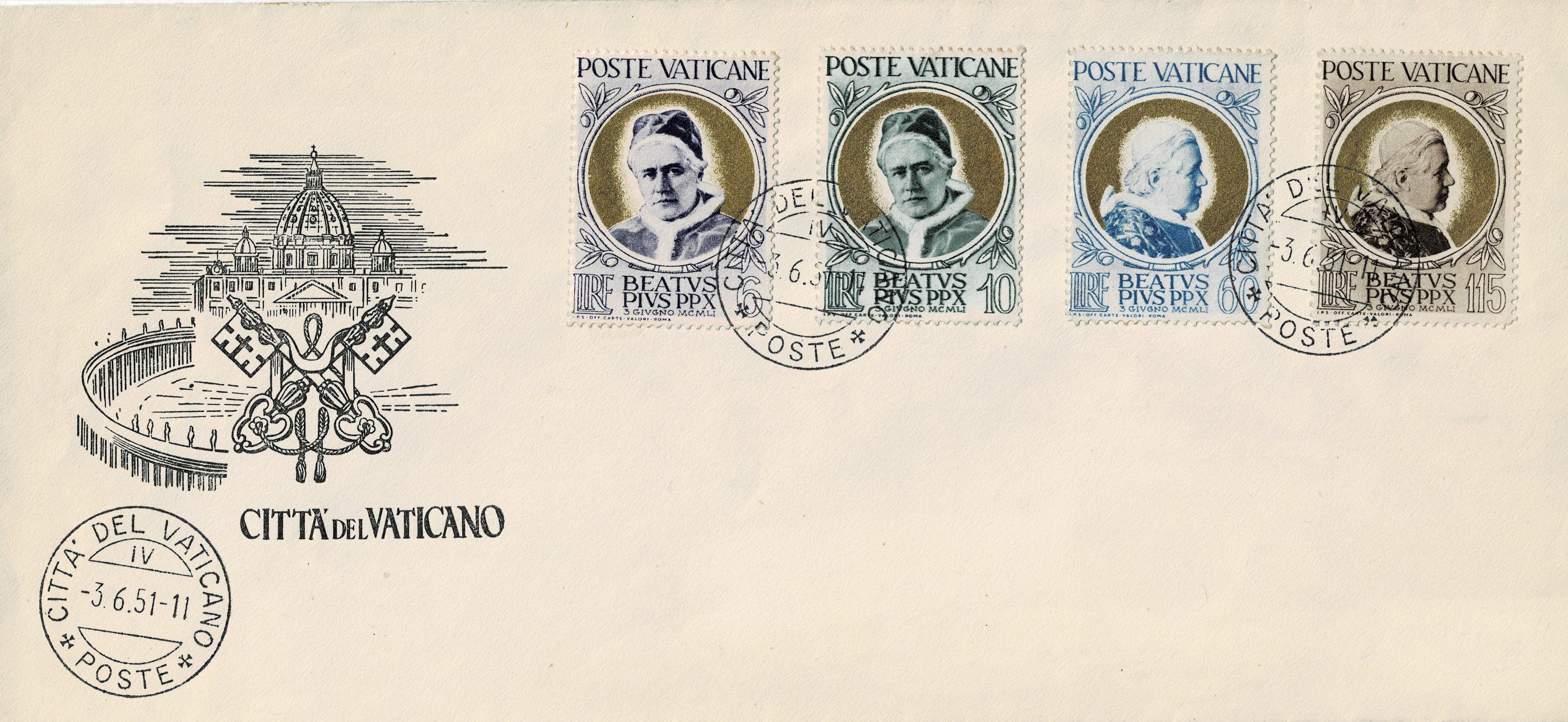





Council of Chalcedon
The fifteenth centenary of the Council of Chalcedon was marked by the release of a series of five stamps. The issue was first placed on sale at the Vatican postoffice on October 31, 1951.
The Council of Chalcedon first was called to session by Pope Leo the Great, in the year 451, under the auspices of the reigning emperor, Marcian. The main purpose of the Council was to destroy the influence of Dioscurus and the Monophysites, and condemn the teachings of Eutyches, that decreed there was only one nature in Christ. After condemning this untruthful belief, the general council formulated the belief of two natures in Christ, that of God and man. The first design of the series (5, 35, 100 lire) shows a view of the General Council, in session. The Council was attended by 130 bishops though some reports place the number at 300.
While the Council was in session in this Greek City, Attila and his hordes of Huns swept into Northern Italy, murdering, pillaging, and burning as they went. The emperor was unable to stop them so he appealed to Pope Leo. Leo went to see Attila and obtained from him the promise that he would leave Italy and make peace with the emperor. The meeting of Pope Leo the Great and Attila is depicted on the 25 and 60 lire stamps.






Roman States Centenary
To mark the hundredth anniversary of the first adhesive postage stamp of the Roman States, the Vatican released a stamp and souvenir sheet depicting a Papal mail coach of the era. In the lower left corner a reproduction of the first Papal stamp of 1852 is shown.
The Roman States (also known as the Papal States, the Pontifical States, and the States of the Church) had their beginning in the year 754, when the Frankish King, Pepin the Short, saved Italy from the clutches of the Lombards. After the defeat, Pepin gave the conquered provinces to Pope Stephen II as the emperor proved he was unable to defend them. This granting of territory was known as the Donation of Pepin and they begin the role of the Pope as a temporal ruler.

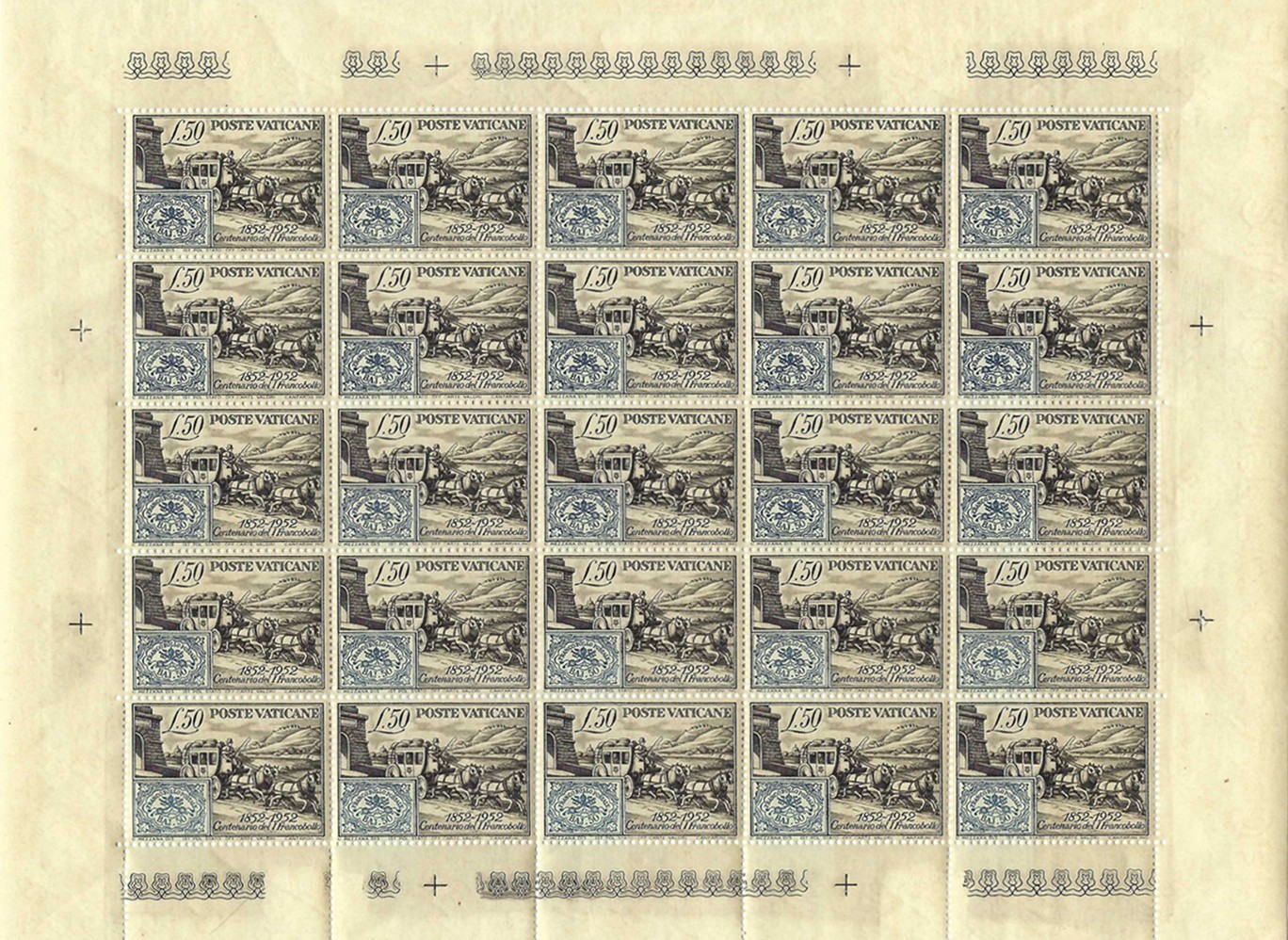

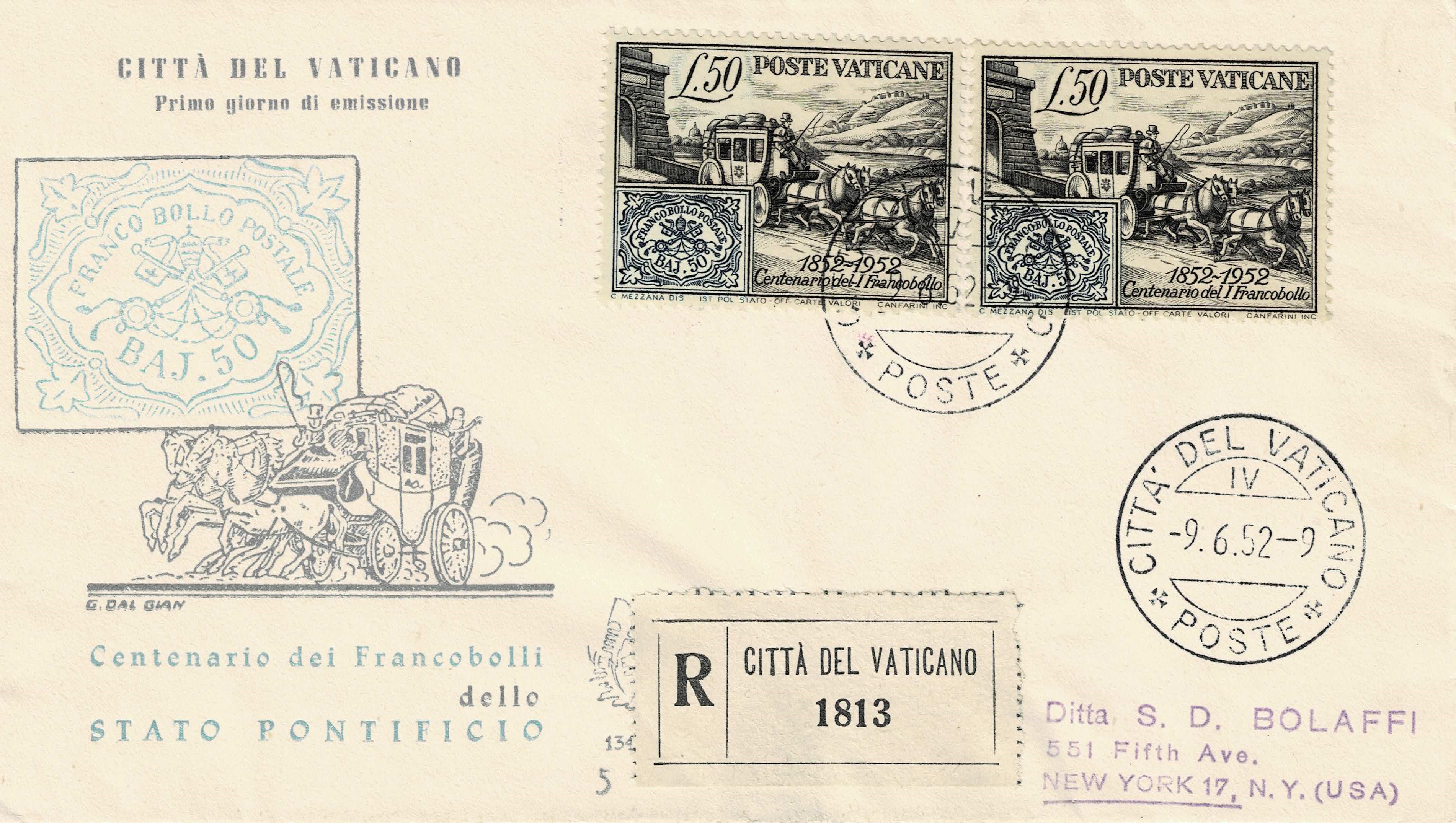




Saint Maria Goretti
On February 12, 1953, a set of two stamps was placed on sale honoring the fiftieth anniversary of the martyrdom of St. Maria Goretti. Maria was born of poor parents at Cordinaldo, a little city near Ancona, Italy. She became a citizen of this world in the middle of the night of October 16, 1890, and baptized the following day, Maria Teressa Goretti. The first six years of her life were passed on the Goretti's "handkerchief size" farm where she grew in an atmosphere of simple, hardworking, religious people. This young lass was happy, good, and pious with a seriousness beyond her age. She never was disobedient even when her brothers prompted her to be.
She was confirmed on October 4, 1896 at the hands of the Bishop of Senigallia. Shortly afterwards, her family moved to Colle Gianturco, where Maria passed the next three years of her life and where the reputation of the inhabitants was as bad as the soil was barren.
Then came the move to Ferriere di Conca, the Mazzoleni estate in the Pontine marshlands. The Goretti family entered into a contract with Giovanni Serenelli and his son, Alessandro. The contract constituted a company living under the same roof and sharing the profits as well as the work. The Serenellis were an unpleasant pair that did not mind cheating the Goretti family of all they could.
Maria's father was stricken with a combination of malaria, meningitis, and typhoid. In his overworked condition he could not muster enough strength to fight it. He begged his wife to return to Corinaldo with the family to enable his children to be brought up in a more favorable environment. After the passing of her father, Maria's mother could not see her way clear financially to make the move. She decided to stay and carry on her late husband's chores as well as her own. Nine year old Maria cheerfully started to perform some of the duties in the house to relieve her overworked mother.















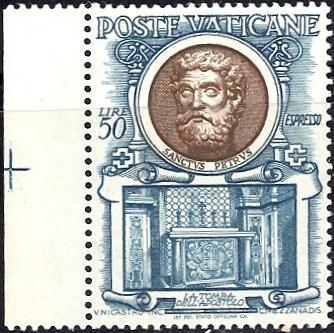

Popes of Vatican Basilica
On April 23, 1953, the Vatican released a new set of definitives. By following the designs of the stamps we are able to view the history of St. Peter's Basilica and Popes who played a prominent role in its erection. "Thou art Peter and upon this Rock I will build My Church; and to thee I will give the Keys to the Kingdom of Heaven . . ." These words were spoken by Christ when He made Peter the head of His Church. They are memorialized on the frieze around the dome and transepts of St. Peter's Basilica.
Peter



3 L: Saint Peter (Scott 158)
10 L: Saint Peter and Tomb (Scott 160)
50 L: (Espresso): Saint Peter and Tomb (Scott E13)
Peter, (derived from petra, meaning rock) was originally called Simon, who followed the life of a peaceful fisherman of Bethsaida. After the Crucifixion of Christ, the Apostles spread to the far corners of the known world. Peter presided over the See of Antioch, where tradition claims he spent seven years.
About the year 42, he went to Rome where he was greeted by a small group of Christians. Peter passed twenty-two years in Rome, spreading the Doctrine of Christ.
In the fateful month of July, 64 AD, Rome burned. The mobs began to mutter the name of Nero and claimed he started the fires to satisfy his ruthless lust and desires. Upon hearing this, Nero blamed the Christians and ordered the persecution of the band that followed Christ's teachings. In the massacre and bloodletting that followed, St. Peter was captured and thrown into the Mamertime, a dreadful prison at the foot of the Capitol. After being kept in chains for eight or nine months he was sentenced to be crucified. Peter faced his martyrdom with great calm and courage. In a final request he asked that he be crucified with his head down, because he claimed he was unworthy to die in the same manner as his Master. The request was granted and Peter went to join Christ in the year 67. His body was laid to rest in a cemetery in the Via Cornelia.
Pope Sylvester I

12 L: Pope Sylvester I and Constantine Basilica (Scott 161)
Pope Anacletus, the second successor of Peter, ordered a funeral chapel erected over the grave. This chapel remained until the reign of Pope Sylvester I. During his pontificate the Emperor Constantine was determined to house the tomb as he felt it should be. He ordered a large and magnificent basilica to be erected over the hallowed spot. A great portion of the Vatican Hill had to be cut away to accomplish this task. It is said Constantine himself carried twelve baskets of earth in the excavating, one for each of the Apostles.
To Pope Sylvester I fell the honor of consecrating the basilica. He is immortalized on the 12 lire stamp, with a sketch of the basilica as built by Constantine.
Pope Julius II

20 L: Pope Julius II and Bramante's Plans (Scott 162)
In 1464, the basilica threatened to collapse. The reigning Pontiff, Nicholas V, decided to demolish it and build a new basilica over the tomb. He gave the task to Bernardo Rosellino who began the work. The first stone was laid during the Pontificate of Julius II. He employed Bramante to plan the basilica. Bramante's idea was to build the basilica in the shape of a cross and crown it with a dome. This was very similar to the plans of Julius who wanted to crown Constantine's basilica with a Pantheon. For his part in laying the first stone on April 18, 1506, and supervising its construction until his death, Julius II is depicted on the 20 lire value with Bramante's design.
Pope Paul III

20 L: Pope Paul III and the Apse (Scott 163)
The next Pope who played a prominent part in the building of St. Peter's was Paul III. He entrusted the work of supervision to the aged Michelangelo. This genius undertook the task in his seventy-second year and refused all offers of pay for his work. He reverted to the original plan of the design of the Greek cross. Michelangelo enlarged the tribune, strengthened the piers of the dome, redesigned the chapels and the apse, and designed the great crowning dome. To this day the dome is referred to as, "Michelangelo's Dome." The great genius left this world in 1564, with only the drum of the dome finished. For restarting the construction Pope Paul III is honored on the 25 lire stamp together with a view of the Apse (rear) of the Basilica completed during his Pontificate.
Pope Sixtus V

35 L: Pope Sixtus V and the Dome (Scott 164)
The dome of the basilica was finished in 1590. The actual time of the building of the dome is disputed, some claim it took two years while others claim ten years elapsed before its completion. The cost also is disputed. Some claim it cost 200,000 gold scudi while others place it as high as 1,000,000 gold scudi. One thing is certain though, it is a marvelous feat of engineering. It took 600 workmen, skilled in their trade, laboring day and night to finish it.
The supplying of the materials to the workmen was a feat in itself. All supplies had to be raised 400 feet by crudely designed implements. For his role in the building of St. Peter's, Pope Sixtus V is shown on the 35 lire value, together with a picture of the dome completed during his reign.
Pope Paul V

45 L: Pope Paul V and the Facade (Scott 165)
During the first year of the Pontificate of Pope Paul V (1605), the form of a Latin cross again was adopted. Paul V wanted to cover the entire area occupied by Constantine's Basilica and planned to do so with the longer arm of the Latin cross.
Carlo Maderno now was the architect-in-chief. He finished demolishing the rest of the basilica erected by Constantine to make room for the longer nave, and the partition wall was knocked down.
Under Maderno's directions, the facade (front) of the church was built. The facade is 369 feet long and 145 fett high. The top is crowned with eighteen foot statues of Our Lord and the twelve Apostles. Paul V was honored by the frieze that appears over the arch leading to the Vatican grounds (this arch is part of the facade). It is inscribed "In honorem Principis Apost. Paulus V Burghesius Romanus Pont. Max. AN. MDCXII Pont VII." This is translated to read "In honor of the Prince of the Apostles, Paul V Borghese, Roman Pontiff Maximus, in the year 1612, the 7th of his Pontificate." He is further honored by the 45 lire stamp that bears his portrait along with a view of the facade.
Pope Urban VIII

60 L: Pope Urban VIII and the Baldacchino (Scott 166)
During the reign of Pope Urban VIII the Baldacchino was built over the tomb of St. Peter. The baldacchino rises one hundred feet above the Altar of the Confession, and weighs ninety-three tons. In front of the altar is a sunken oval space with a marble balustrade. The altar itself is reserved for celebration of the Mass by the Pope only. He reads the Mass while facing the congregation. The erection of the baldacchino (canopy) was not the most important part Urban VIII played in the history of the Basilica. Maderno had finished the basilica and the Pope solemnly consecrated it on November 18, 1626.
Urban VIII is remembered for his role in building the basilica, on the 60 lire value. Below the likeness of the Pope is a view of the baldacchino and the Altar of the Confession.
Pope Alexander VII

65 L: Pope Alexander VII and the Colonnade (Scott 167)
While Alexander VII was the reigning Pontiff, Giovanni Bernini was engaged to build the impressive colonnades. These two rows of columns really are the vestibule of St. Peter's. The colonnades are keyhole in shape, somewhat circular as you enter the square and then straighten out when you reach the basilica. They are purely ornamental and serve no positive need. Each of the colonnades are 64 feet high and 61 feet wide. Between the two colonnades one can count 284 columns arranged in four rows. The spaces between the columns form three covered arcades with the center one in each colonnade wide enough to accommodate two automobiles driving abreast. Atop the rows of columns are 162 statues eleven feet tall. The colonnades form the border of St. Peter's square. The square is 1,110 feet long and 786 feet wide. In the center is the obelisk raised in 1586, by Pope Sixtus V (35 lire stamp) flanked by two fountains. Alongside the fountains are two red and white discs. When you stand on the discs the columns arranged in four rows are so placed that it seems as if only one row is there. For his contribution to the basilica, Pope Alexander VII is shown on the 65 lire value, with a section of one of the colonnades.
Pope Pius VI

100 L: Pope Pius VI and the Sacristy (Scott 168)
When Pius assumed the responsibilities of the Papal Throne the basilica proper and the square was finished. Wishing to add to the church he set about to build the sacristy. It is a building in itself but attached to the basilica proper by means of two passageways. The sacristy is located about the middle of the left side of the church and consists of four large rooms. Some, of the art treasures found among them are the fluted pillars from the villa of the pagan emperor Hadrian, the vestments worn by Charlemagne when he was crowned the first Holy Roman Emperor by Pope Leo III, three rows of candlesticks and, candelabra, and many rows of chalices and ciboria. To commemorate the erection of this addition, Pope Pius VI is depicted on the 100 lire stamp over a view of the sacristy and the connecting passageway to the basilica.
Pope Pius XII


5 L: Pope Pius XII and Roman Sepulcher (Scott 158)
85 L (Espresso): Pope Pius XII and Roman Sepulcher (Scott E14)
Pope Pius XII, the reigning Pontiff, is portrayed on the 5-lire and 85-lire stamps. He contributed to the basilica by his great and active excavations below the church. These excavations have unearthed many startling discoveries hitherto unknown to the world. These diggings under the basilica are known as the Sacred Grottos. A visit to the grottos finds a sort of a basilica with a nave and two aisles artificially illuminated with great skill. The grottos have served as a burial place for Popes, Cardinals, and Sovereigns. They now are adorned with statues of personages of fame, chapels, and the life and history of the Popes buried there.
The new designs by Pius XII practically have doubled the size of 'the grottos as they appeared during the reign of his predecessor, Pope Pius XI.

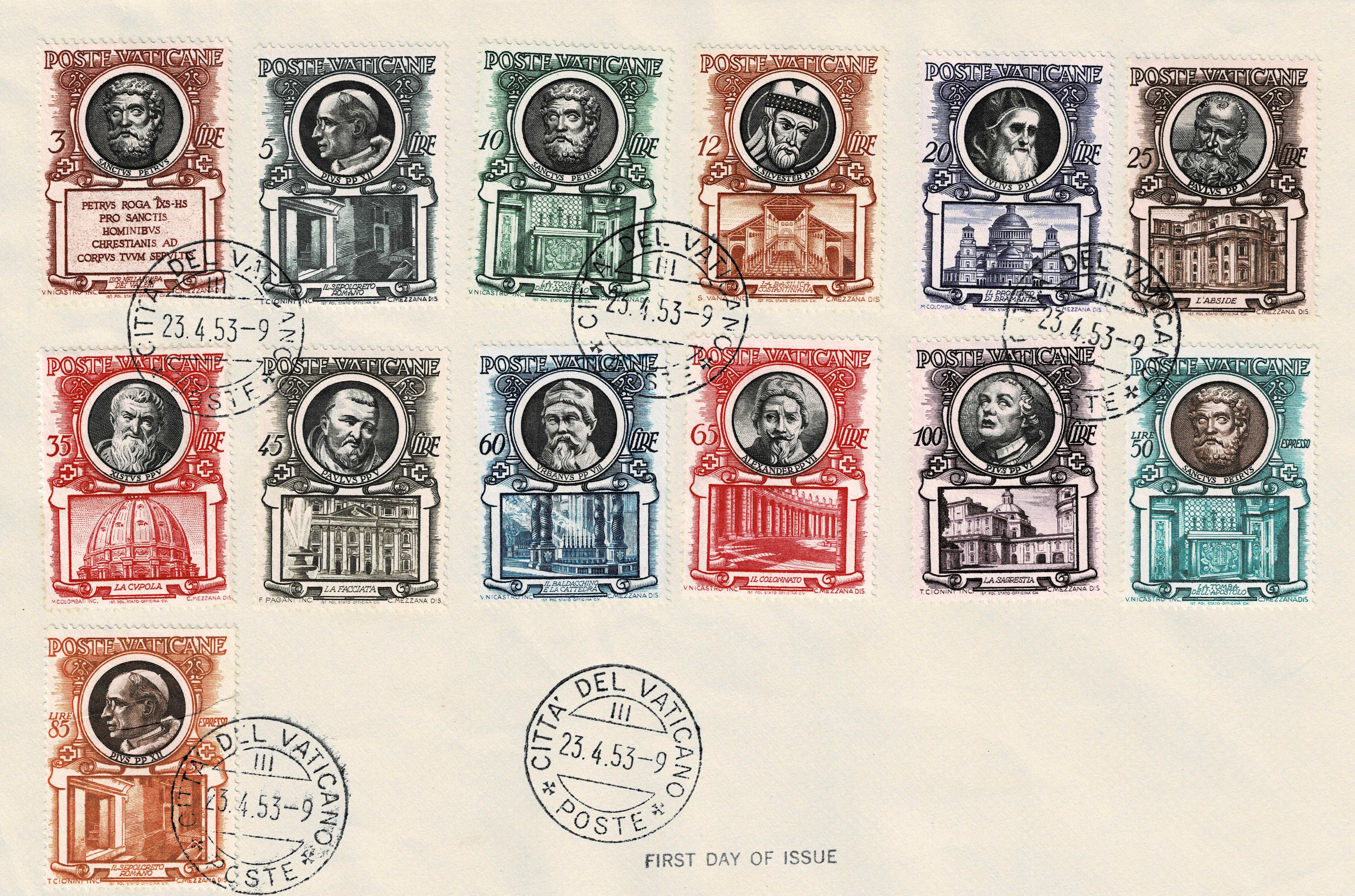


Saint Clare of Assisi
It was Palm Sunday, March 17, 1212, and the People of Assisi were attending Holy Mass. Suddenly, and without ceremony, the Bishop of Assisi left the altar and went among the faithful to present a branch of palm to a young and bashful maiden, St. Clare.
That evening when darkness had fallen, Clare left her home and went to the Church of the Portiuncula where she met Saint Francis and his fellow Brothers. Francis accompanied Clare to the altar of Our Lady. He then cut off her hair and gave her his simple habit, a piece of sackcloth with a cord as a girdle. It was with this simple rite that an eighteen-year-old virgin of noble birth had dedicated her life to God.
Clare left Saint Francis and journeyed to San Damiano, just outside of Assisi. She obtained a battered house and established the first convent of the Franciscan Nuns. This new order of nuns was named "Poor Clares" after its foundress.
It wasn't long before Clare's fourteen-year-old sister, Agnes, came to join her. She was followed in a short time by Clare's mother and other women of noble birth. The nuns tended the sick and at Clare's intercession, many were cured.
When the Saracen army of Frederick II was ravaging the valley of Spoleto, a small group of his soldiers went to pillage the convent. Clare had the Blessed Sacrament placed in a monstrance above the gate leading to the convent. She knelt before it and prayed that the nuns, and the convent would be spared. The invading soldiers were standing about when a voice from the Host answered, "My protection will never fail you." A sudden panic seized the patrol and they fled, leaving the Convent and nuns unharmed. With the exception of the time Clare went to Saint Francis to talk of God, she never left her voluntary confinement. This did not cut her off from the world, however. She exerted great influence from the simple convent and many bishops, cardinals, and even two Popes came to her seeking advice and consultation.
It wasn't long before other convents of Poor Clares began to spring up in many places. The nuns of this Franciscan order went barefoot and constantly observed perpetual abstinence, constant silence, and poverty. Cardinal Ugolino imposed a rule on the order that forbade communal poverty. Clare spent thirty-two years struggling for the restoration of the true Franciscan rule without success. Then, on August 9, 1253, her request was granted. Pope Innocent IV had heard her plea and restored the Franciscan rule.
Clare's twenty-eight-year illness came to an end on August 11, 1253. It was on this fateful day, while the passion was being read, Clare left this world. She was canonized two years later by Pope Alexander IV and her remains laid to rest under the high altar of the church that bears her name, Santa Chiara at Assisi.
To honor the seventh centenary of the death of St. Clare, the Vatican Postal Administration released a set of two stamps on August 12, 1953, the day set aside by the church as her feast day.




Saint Bernard
On November 10, 1953, the Vatican City honored the eighth centenary of the death of St. Bernard by the release of a set of two stamps. Bernard entered this earthly world in 1090, at the castle of Fontaines, near Dijon, Burgundy. His parents saw great undertakings for this young lad blessed with great intellect and grace. Bernard shattered their dreams forever when he renounced the royal splendor and joined the Monks of Citereaux. Shortly after entering the order he was made Abbot of the fourth house at Clairvaux, where his brothers joined him as monks. Bernard was very harsh with himself and he expected his followers to be equally strict with themselves. Many were disheartened at his severity. He soon realized his errors and eased his rule thereby boosting the morale of the monks.
In spite of his desire to remain away from the world at large, Bernard's fame spread rapidly. Many churches had requested him as their Bishop, but through the aid of Pope Eugenius III, he escaped the fulfillment of the requests. Though Papal intervention had saved him from the Bishopric, his monastery constantly was invaded by the poor and weak seeking his protection, and bishops and kings seeking his advice. In time Pope Eugenius charged him with preaching a Crusade in France and Germany. Through his efforts two large and splendid armies were formed and dispatched to the Holy Land where they defeated the infidels.
Bernard's fame was not limited to founding monasteries and preaching the crusade. His other achievements were just as amazing; assisting at ecumenical and other councils, opposing and refuting Abelard, writing treatises and sermons, and even entering politics to preserve the peace of the Church. It has been said that "he carried the twelfth century on his shoulders and he did not do it without suffering."
Like all humans, Bernard was not destined to remain on earth forever, and on August 21, 1253, he closed his eyes for the last time and went to his final reward. His works and memory were not forgotten. Through his great teachings and writings he earned for himself the titles of the last of the Fathers and a Doctor of the Holy Church.
Bernard was canonized in 1274, and his relics preserved at Clairvaux and Troyes. This was not the end of the honors bestowed upon this great saint, August 20th of each year has been set aside by the Catholic Church as his feast day.



Peter Lombard
On December 29, 1953, Vatican City released a single stamp of the 100 lire denomination without any advance notice. The stamp has been generally accepted as the Pier Lombardo issue. No issue of Vatican City to date has caused as much a turmoil as this one. Hundreds of collectors have written to find out who Pier Lombardo (Peter Lombard) was, what were his works, and why a stamp was issued in his honor. After months of research, both here and abroad, we are pleased to list all the known facts to date about Peter Lombard and the issuance of this stamp.
The Man
Peter Lombard was born in 1100, at Novara or Lumello, Italy. He studied at Bologna, Rheims and Paris. In 1158-59, he was appointed as Archbishop of Paris but held the office only a very short time. He met his death not later than 1164, (exact date unknown) never returning to Italy, the land of his birth.
His Works
The works of Peter Lombard, the Archbishop of Paris consisted of:
1. Commentaries on the Psalms of St. Paul.
2. Sermons.
3. The Sentences known as "Quartutor libri Sententiarum."
It was the Sentences, a theological work covering all theology systematically and well, that gave him his fame. His chief sources of information were Abelard, Francis Gratian (see airmail stamps of 1951), Ivo of Chartres, and Alger of Liege. The Sentences were mainly a compilation with less than ten lines being the original work of Archbishop Lombard. It was his aim to compile one book that would end the need of references to many books for information. His works on the Sentences were used up to the sixteenth century as the textbook for university courses and earned for Peter Lombard the title of Magister Sententiarum (Master of the Sentences).
The Stamp
The stamp issued as the Pier Lombard commemorative depicts the Episcopal Seal he used as Archbishop of Paris. The seal is of white wax (a color very infrequent in Episcopal Seals) and oval in shape. The inscription on the seal reads "Sigillum Magistri Petri Parisiensis Episcopi." The figure in the center of the seal is an effigy of Peter Lombard in Pontifical garb with a banner. His right hand is raised for benediction, while the pastoral cane is held in his left hand.
The mitre (official headdress of bishops) worn by Peter Lombard and reproduced on the seal, is unique. It was the first time the mitre appeared with two horns, a style originated by the Archbishop of Paris. A careful examination of all seals and documents prior to the eleventh century reveals that no example of the mitre in this style existed before Peter Lombard. After Peter's inauguration of the horns it was adopted by a number of bishops including: Archbishop Hugo of Rouen (1154), Archbishop Guglielmo of Sens (1169-77), and Bishop Arnolfo of Lisieux (1170). Bishop Arnolfo revised the mitre by adding an ornate cord to separate the two horns. Among the Bishops who wore this revised version of Lombard's mitre were Bishop Cuniberto of Torino and Bishop Alteremanno of Trent. The style of the mitre with horns began to die out in the second half of the twelfth century. The seal of the Archbishop of Paris, Peter Lombard, is important because it preserves the only known picture of a great person. The original seal is housed in the Archives of Paris.
Stamp Commemoration
While the common name applied to this stamp is the "Peter Lombard Issue," it really was issued to mark the seventh centenary of Lombard's "Quartuor libra Sententiarum" more commonly known as the "Book of Sentences" or the "Book of Opinions". The Episcopal Seal of the Archbishop of Paris was chosen as the main design of the stamp as it was reproduced in the libiri Sententiarum which this stamp commemorates.
Designing of the Stamp
While this stamp bears a reproduction of the seal, it was Edmondo Pizzi, a noted designer of Vatican stamps, that chose this as the subject. In addition he executed the fine scroll-like work and lettering that completes the design of the stamp.
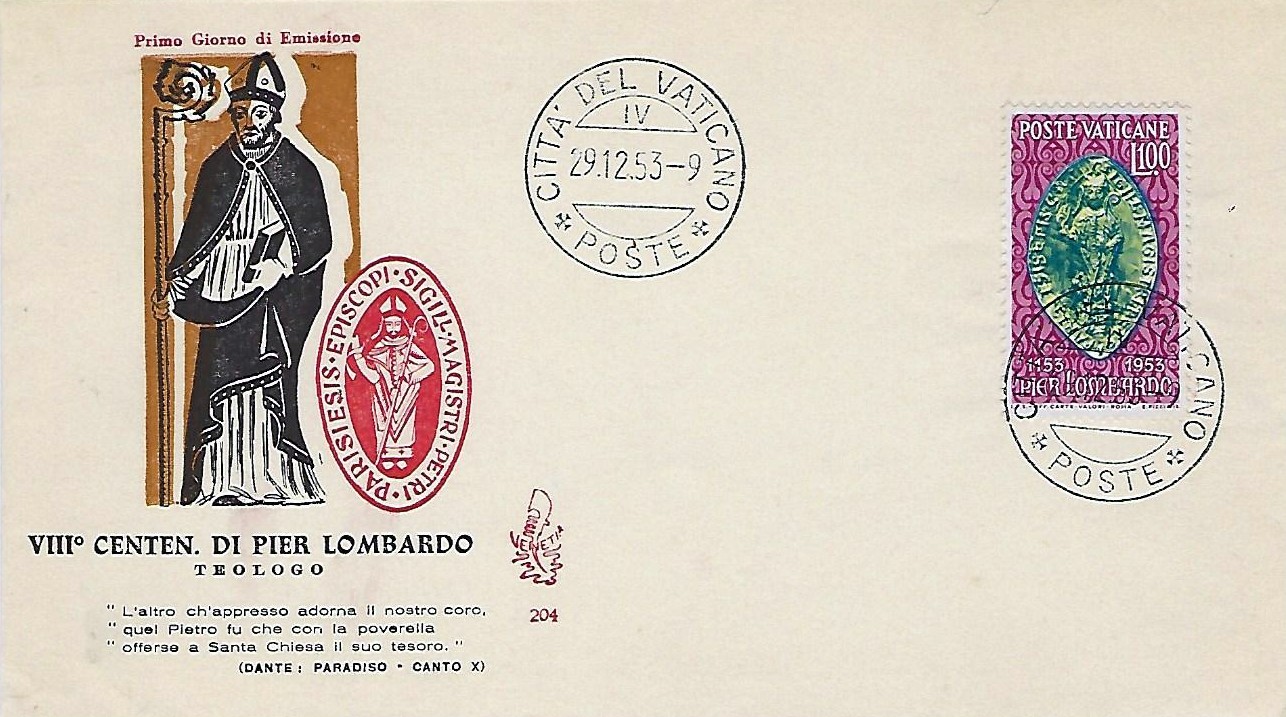



The Lateran Pact
It was raining quite hard on the morning of February 11, 1929. Several automobiles containing Cardinal Gasparri and his party drove up to the Lateran Palace. The Pope's representatives entered the Hall of Constantine. At noon the representative of the King of Italy, Premier Mussolini and his party entered the hall and were greeted by the Papal representatives. After the exchange of cordialities, Cardinal Gasparri and Benito Mussolini signed the three documents that comprised the pact, with a gold pen sent by Pope Pius XI for the signing. In less than a half hour's time the treaty was signed with only a handful of high dignitaries of the Church and State being present. The bells of St. John Lateran pealed joyously as the signatures were affixed and a group of theological students chanted the "Te Deum" in the square below. The two dignitaries shook hands, congratulating one another and departed. The Roman Question had been answered! The Lateran Treaty (so named because it was signed at the Lateran Palace) created the tiniest nation in the world, the State of Vatican City, and re-established the Pope's sovereignty and independence. The treaty further states that the Italian government would have Catholicism as its only state religion, recognize the Vatican territory as neutral and inviolable, change Civil Laws that conflicted with Canon Law, and make Catholicism compulsory in the schools.
Other provisions of the documents provided that the Italian government would build a railroad station in the Vatican and establish direct communications with other states, including a postal service. The right to send and receive diplomatic representatives to foreign countries also was agreed to according to international law.
Immunities were granted to church dignitaries, and officials for the territory outside the Vatican proper, as well as the parcels of land themselves. A working agreement was also reached to protect the Vatican and provide for the apprehension and extradition of criminals and fugitives.
The Lateran Pact also stipulated that an indemnity of 750,000,000 lire in cash and 1,000,000,000 lire in Italian interest-bearing bonds was to be paid the Vatican for the loss of temporal power in 1870. Though the treaty was signed on February 11th, it did not go into effect until noon of June 7th. At that time the government of the new state began to function, Swiss Guards took their posts at the new boundaries of the Vatican state and rolled back the bronze doors of the Vatican Palace that had been closed since the fall of Rome in September, 1870. The Pontiff was a Prisoner of the Vatican no longer.
To commemorate this important treaty, the Vatican Postal Administration released a set of two stamps depicting Pope Pius XI and a view of Vatican City. The stamps were placed on sale on February 12, 1954, to mark the silver anniversary of the signing. The stamps could not be released on the actual anniversary date as it was a Holiday and the post office was closed. Italy also marked the signing of the Lateran Pact with a set of two stamps depicting the Lateran Palace where the treaty was signed.
Technical Details:
Scott Catalogue - 174 - 175
Date Issued - 12 February 1954
Face Value - 25 l, 60 l
Perforations - 13
Printer - The Italian State Printing Works

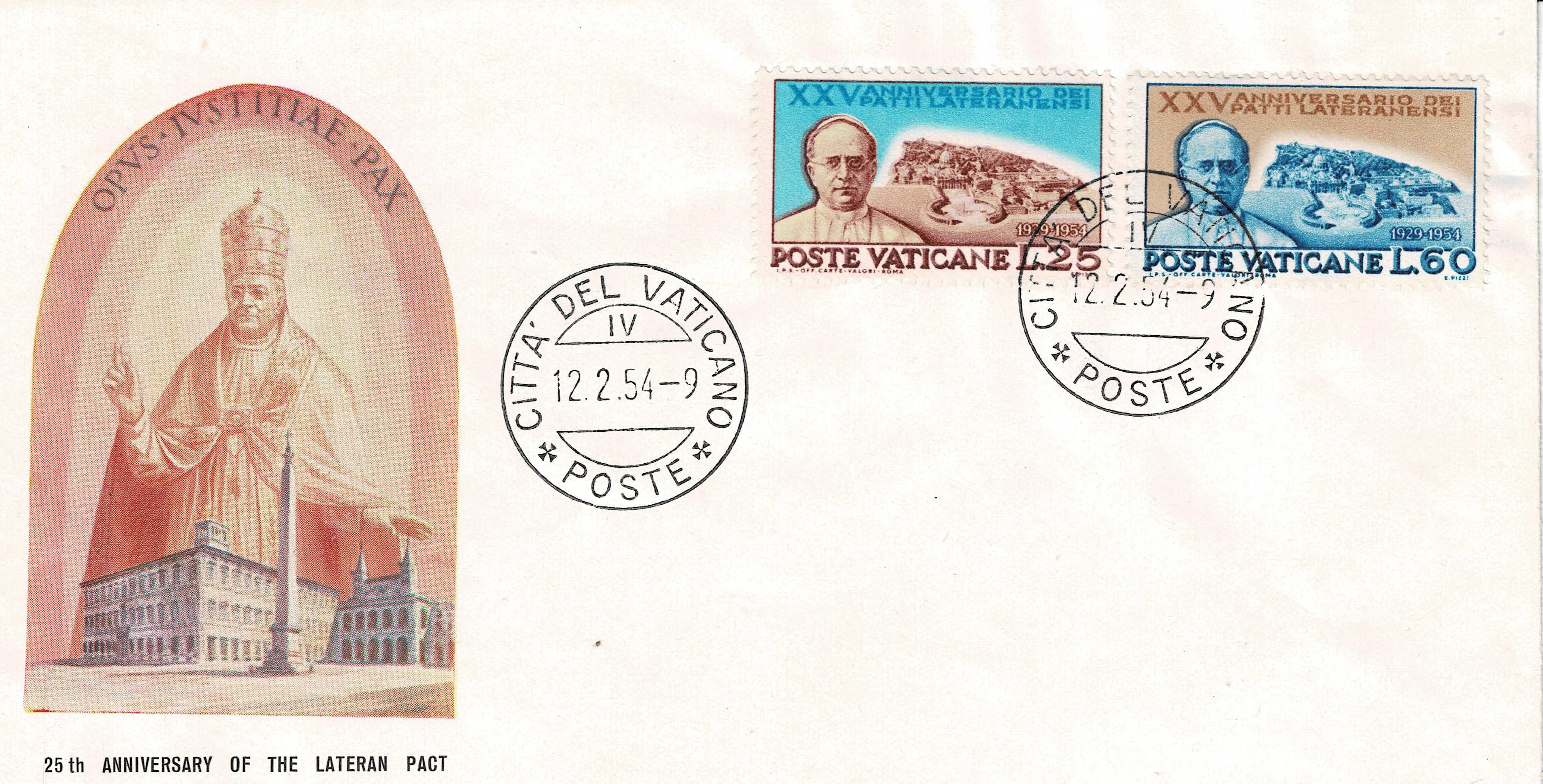






The Marian Year
Pope Pius IX (3, 6, and 20 lire stamps) was born on May 13, 1792 of noble parents in Senigallia and baptized Giovanni Maria Mastai-Ferretti. As a young lad he knelt before the highly venerated picture of Our Lady in the Cathedral of Senigallia and consecrated his life to the glory of God and to dedicate his virginity to her.
At the age of ten years, young Giovanni made his first Holy Communion on Feb. 2, 1803, the feast of the Purification, in the Cathedral where he was baptized. A year later he entered the College of the Scolopi, at Volterra, to begin his studies. While attending this school the first sign of epilepsy appeared and threatened to render his ordination as a priest of God impossible. In 1809, he entered the Roman College to study theology, philosophy, and the classics. In 1815, on the feast of the Annunciation, he enrolled in the Senior Marian Sodality of the Roman College. On April 10, 1819, young Giovanni was ordained a priest, thus beginning a new life that was to end in the Chair of Peter.
His life as a priest saw the future Pope Pius IX spend his first four years with youth. He was then sent by the Holy Father to South America to serve as Auditor to the Apostolic Delegate, Monsignor Muzzi. In 1825, he was appointed by Pope Leo XII as Arch-bishop of Spoleto. Seven years later the successor to Leo XII, Pope Gregory XVI transferred him to the larger dioceses of Imola. In 1839, Archbishop Mastai-Ferretti was bestowed with the red hat of Cardinal.
Pope Gregory XVI died on June 1, 1846, and Cardinal Mastai departed from his See to attend the Conclave in Rome. At Fossombrone a white dove alighted on the carriage and stayed there until it arrived at the gates of Rome, as if a sign to the people that the Cardinal was to be the next Vicar of Christ. Fifteen days later he became Pope Pius IX. Upon assuming the Throne of Peter, Pius IX set up a commission of Cardinals and theologians to study the belief generally accepted of the Immaculate Conception. On Feb. 2, 1849, he took a step further and invited the bishops of the entire Catholic Church to freely express their views on proclaiming the Immaculate Conception an infallible Dogma through his Encyclical, Ubi Prium. Of the 593 expressions given, only four were against the proclamation. As a result of this poll, Pope Pius IX convened a secret consistory on December 1, 1854. He then asked the assembled Cardinals, "Is it then your pleasure that we utter the dogmatic decree on the Immaculate Conception of the Blessed Virgin Mary?" The Cardinals unanimously agreed and the reigning Pontiff set Dec. 8, 1854 as the day of the promulgation of the Dogma of the Immaculate Conception.
On the morning of Dec. 8, 1854, the Solemn Pontifical Mass in St. Peter's Basilica began. After the singing of the Gospel the Holy Father stood on the steps of his throne surrounded by a vast retinue of Cardinals and bishops and solemnly sanctioned, "that the doctrine, which holds that the Most Blessed Virgin Mary at the first moment of her conception was, by singular grace and privilege of the Omnipotent God, in virtue of the merits of Jesus Christ, Savior of the Human race, preserved from all stains of original sin, is revealed by God, and therefore, to be firmly and resolutely by all the faithful." After the solemn definition of the Immaculate Conception had been decreed the crowds cheered wildly and shouted "Viva Mary Immaculate." The cannon of Castel St. Angelo saluted as the bells of the churches of Rome tolled to announce the Dogma of the Immaculate Conception.
When the Mass was over Pope Pius IX blessed a golden crown studded with jewels. He then was borne on his portable throne to the Chapel of Sixtus IV where he placed the crown on a statue of Mary.
Like his predecessor, Pope Pius XII (4, 12, and 35 lire stamps) is also. dedicated to the Mother of God. At baptism he received the name of Mary as his first middle name. When he was ordained a priest he said his first Mass in one of the chapels of St. Mary Major, the most prominent basilica in Rome dedicated to the Blessed Virgin.
On Oct. 30, 1950, the Holy Father was taking his afternoon walk in the Vatican Gardens. At 4 o'clock, as he turned his gaze from the gardens to the sun, he saw a vision of the Mother of God in the rays of the sun. The following afternoon Mary again appeared to the Pope at the same time. The next day, Nov. 1, 1950, Pope Pills XII gave to the Catholic Church the second important Dogma of Mary, the Dogma of the Assumption. As if to show her approval for the solemn definition of the assumption of Her body and soul into heaven, Mary appeared again to the Pontiff that afternoon at the same time as the previous days as he strolled in the gardens.
On Sept. 8, 1953, the feast of the Nativity of the Blessed Virgin, Pope Pius XII called upon the faithful to join in the observance of the Marian Year which he decreed through his Encyclical, Fulgens Corona Gloriae. The Marian Year, the first year dedicated to the Mother of God in the Annals of the Catholic Church, was decreed to extend from Dec. 8, 1953 to Dec. 8, 1954, to mark the centenary of the Dogma of the Immaculate Conception.
On Dec. 8, 1953, Pope Pius XII left the Vatican and drove through downtown Rome for the first time since the end of World War II. In the Piazza di Spagna, at the foot of the Spanish Steps, the czar came to a halt. The Pontiff placed a bouquet of flowers at the column commemorating the Immaculate Conception. Then he was driven to the Basilica of St. Mary Major to preside at the ceremonies inaugurating the Marian Year.
The Holy Father entered the church under a canopy of velvet and damask as the choir sang the triumphant "T u es Petrus." With members of the Catholic Action group he recited the special Marian Year prayer he had written. This marked the beginning of the Marian Year.
On May 26, 1954, a set of six stamps was issued to mark the Marian Year Two major designs were used for the motifs of the stamps. The first was an effigy of Pope Pius IX, who proclaimed the Dogma of the Immaculate Conception. The second design features the reigning Pontiff, Pope Pius XII who promulgated the Marian Year to mark the centenary of this important Dogma of the Mother of God.
Technical Details:
Scott Catalogue - 176 - 181
Date Issued - 26 May 1954
Face Value - 3 l, 4 l, 6 l, €1.25, 12 l, 20 l, 35 l
Perforations - 13
Printer - The Italian State Printing Works





Canonization of Pope Pius X
"This hour of splendid triumph—as God, Who lifts up the lowly has arranged and as it were hastened in order to set His seal on the marvelous elevation of His faithful servant Pius X, to the supreme glory of the altars . . ." With these words Pope Pius XII solemnly proclaimed Blessed Pius X as the 4,374th saint of the Catholic Church, on May 29, 1954.
The following morning the pontifical canonization Mass was said by Eugene Cardinal Tisserant, dean of the Sacred College of Cardinals and presided over by Pope Pius XII. Before the main altar a special platform held the remains of the newly pronounced saint in a glass and gold casket throughout the ceremonies. In a prominent place the relatives of the first Pope to be canonized in 242 years heard the Mass marking the elevation of Pius X to sainthood. An important place also was given to the two people whose miraculous cures through the intercession of Blessed Pius X made the canonization possible, Sister Maria Luisa Scorcia of the Daughters of Charity of St. Vincent de Paul, and the Neapolitan lawyer, Francesco Belsani. When the Mass was concluded, Pius XII was carried out of the basilica among the crowd of over half a million who were assembled in the Square. He constantly gave them his blessing and then appeared on the balcony where the crowds were better able to see him.
That afternoon the remains of St. Pius X were placed on an elegant old Berlin carriage drawn by six white horses. The long procession in honor of the newly proclaimed saint escorted the carriage across the city of Rome to the basilica of St. Mary Major, where the casket was exposed to the faithful.
We already have noted the reasons for the Beatification of Pius X, but what is canonization? Canonization Is the next and supreme step in pronouncing a person to be in Heaven. All that is necessary to make the step from Beatification where the person is bestowed with the title of "Blessed" and Canonization where he is conferred with the title of "Saint" are two miracles. These miracles must occur after the beatification. They then are submitted to a vote of the Sacred College of Cardinals and certain other prelates in a semi-public consistory.
Canonization places the final seal of approval of the Church on the asserted sanctity of a person. While beatification only permitted veneration of Pius X on a very limited scale, his canonization declared he actually is in heaven and the faithful are ordered to venerate him throughout the entire Catholic Church.
Technical Details:
Scott Catalogue - 182 - 184
Date Issued - 29 May 1954
Face Value - 10 l, 25 l, 35 l
Perforations - 13
Printer - The Italian State Printing Works










The First Airmail Issue
On June 22, 1938, the Vatican City issued its first set of airmail stamps. The series was composed of eight values with four designs common to two denominations.
The 25 cent. and 1 lira stamps depict the statue of St. Peter, by Defabris, in the Piazza of St. Peter's. The statue is one of a pair (the other is a statue of St. Paul by Tadolini) erected during the Pontificate of Pope Pius IX. The original statues of these saints that stood at the base of the stairs rising to the basilica were moved to the entrance of the sacristy. Pius IX then replaced the statues of the two Apostles with those mentioned above. A symbolic design was used for the motif of the 50 cent. and 2 lire stamps, a dove with an olive branch superimposed on a scene of St. Peter's Square. The design represents the usage of the airways for peaceful purposes.
The ascent of Elias into heaven is portrayed on the 75c and 6L values. IV Kings, II, 7-11: ". . . but they two stood by the river Jordan. And Elias took his mantle and folded it together, and struck the waters, and they were divided hither and thither, and the both passed over on the dry ground. And when they had gone over, Elias said to Eliseus: Ask what thou wilt have me do before I be taken from thee . . . And as they went walking and talking together, behold "A FIERY CHARIOT AND FIERY HORSES PARTED THEM BOTH ASUNDER: AND ELIAS UP BY A WHIRLWIND INTO HEAVEN."
A third use of the airways is depicted on the 80c and 10L values: the transportation of the Loreto Holy House. According to tradition, Our Lady's home in Nazareth was enclosed in a beautiful church named the Basilica of the Annunciation by the Empress Helena. The name of the church was very appropriate as it was in this house that the Angel Gabriel appeared to Mary and announced she was to be the Mother of the Christ Child. The basilica enshrining the Holy House of Nazareth stood for about nine hundred years. When the basilica had fallen into the hands of the Saracens it was allowed to fall into disrepair. Towards the end of the thirteenth century the Home of Mary disappeared.
A short while later the people of Tersatto, a vilage in Dalmatia, were astonished to find a house in an open field where there had been nothing the day before. The parish priest said it was the Holy House of Nazareth and it had been revealed to him in a dream. The envoys of the Governor forwarded a report that the House had disappeared from Nazareth and that It was of the same size and shape as that found in the field. The report further stated that the materials used for the construction were unobtainable anywhere in Dalmatia.
Three years later the House vanished again. It was located this time on the other side of the Adriatic Sea a few miles south of Ancona. It shifted slightly two or three times and then found a final resting place in a laurel grove that gave its name to the place. Since that time the Home of Mary has been known as the Holy House of Loreto.




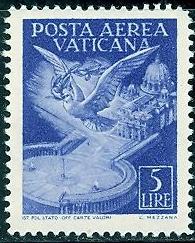

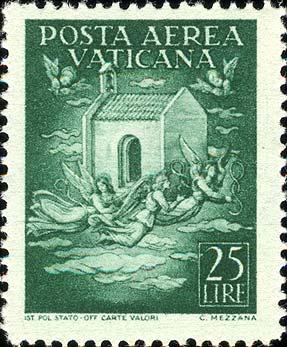


Airmails of 1947
On November 10, 1947, a second issue of airmail stamps was placed on sale to meet the increased postal rates. Three different designs were used for the motifs of these seven stamps.
The 1 and 5 lire stamps again depicted the Dove of Peace. This symbol of the peaceful use of the airways differs from that of the first airmail issue in that the dove is depicted over the basilica and square of St. Peter's.
The Holy House of Loreto again is reproduced on the 4 and 25 lire values of this issue. The House had found its anal resting place on the Lauretum Hill on December 9, 1294. The church of Sanctuaro della Santa Casa was built to enshrine the little chapel where the Word was made Flesh. The church was begun in 1465, and is one of the finest in all of Italy. The actual Holy House was richly encased in marble and adorned with carvings relating to the miraculous flight. Inside the House, measuring 15' X 15' X 30' without foundations, is a Madonna made of cedar wood taken from the Vatican Gardens. During the reign of Pope Benedict XV the Holy Father declared Our Lady of Loreto as the Patroness of Aviation with December 8th as the feast day in the Church of the Holy House.
The remaining stamps of this series, (15, 50 and 100 lire) depict the obelisk brought from Heliopolis to Rome by the Emperor Caligula and raised on the "spina" of his Circus. The "needle" stood at this location for a few centuries and witnessed the persecution of Christians; even St. Peter met his martyrdom near the obelisk. In 1586, Pope Sixtus V ordered the obelisk moved to the center of St. Peter's Square and en-trusted Domenica Fontana with the task. The obelisk was lowered and placed on rollers to be moved the short distance to the square. It took nine hundred men and fifty-two shafts to get this three hundred twenty-two ton monument in place. While the obelisk was being raised on September 10, 1586, silence was imposed under pain of death on the bystanders less they distract the workmen. As the huge piece of granite was moved into position on the thirteen rollers that had transported it from the Circus, eight winches turned by sixteen horses and eight men started to raise the obelisk. Suddenly the ropes began to strain and look as if they would break. The silence was shattered with a shout of, "Wet the ropes!" by a sailor named Bresca of San Remo. The ropes contracted and the obelisk was raised. A bronze cross, containing a fragment of the True Cross, was placed on the top of the obelisk. Thus a pagan monument supports the beginning of Christianity. What a wonderful crown!
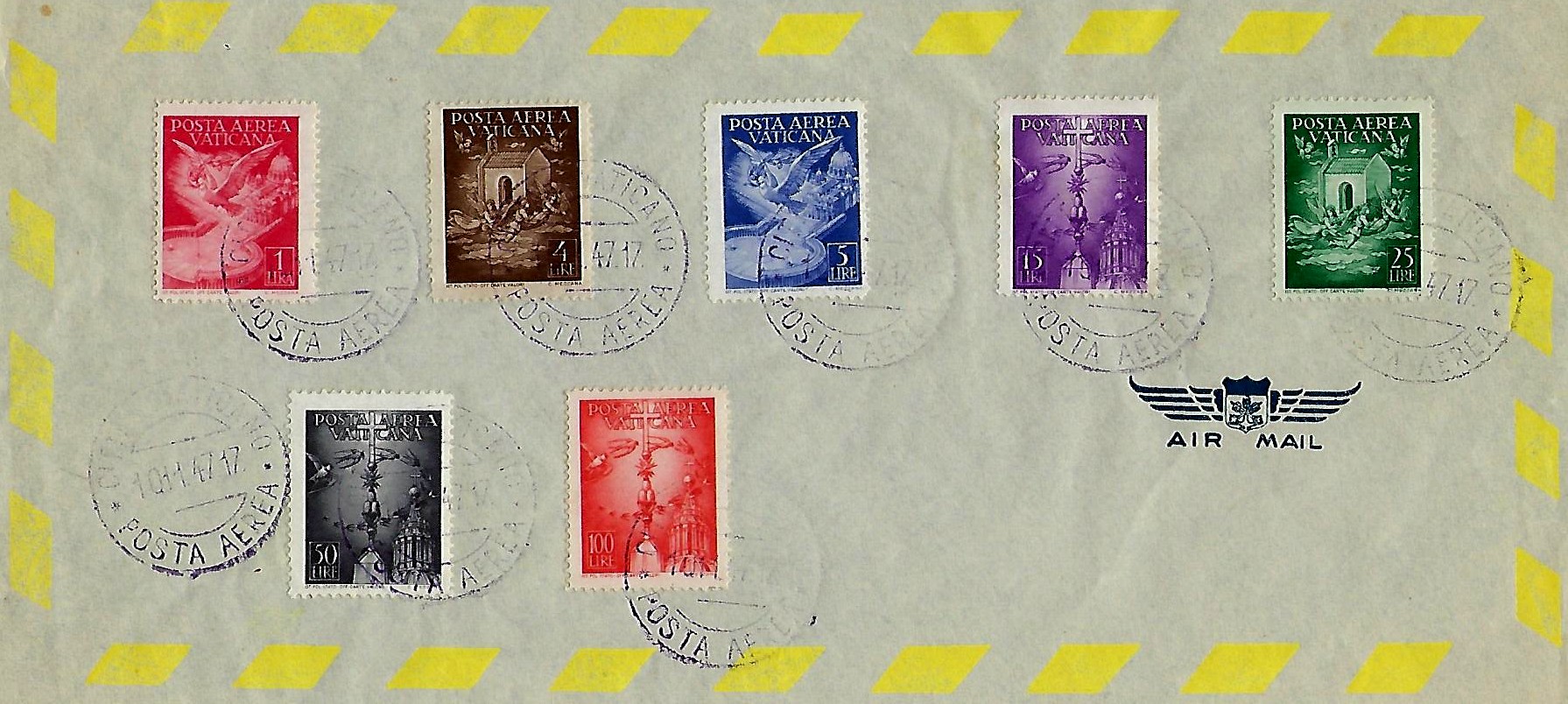
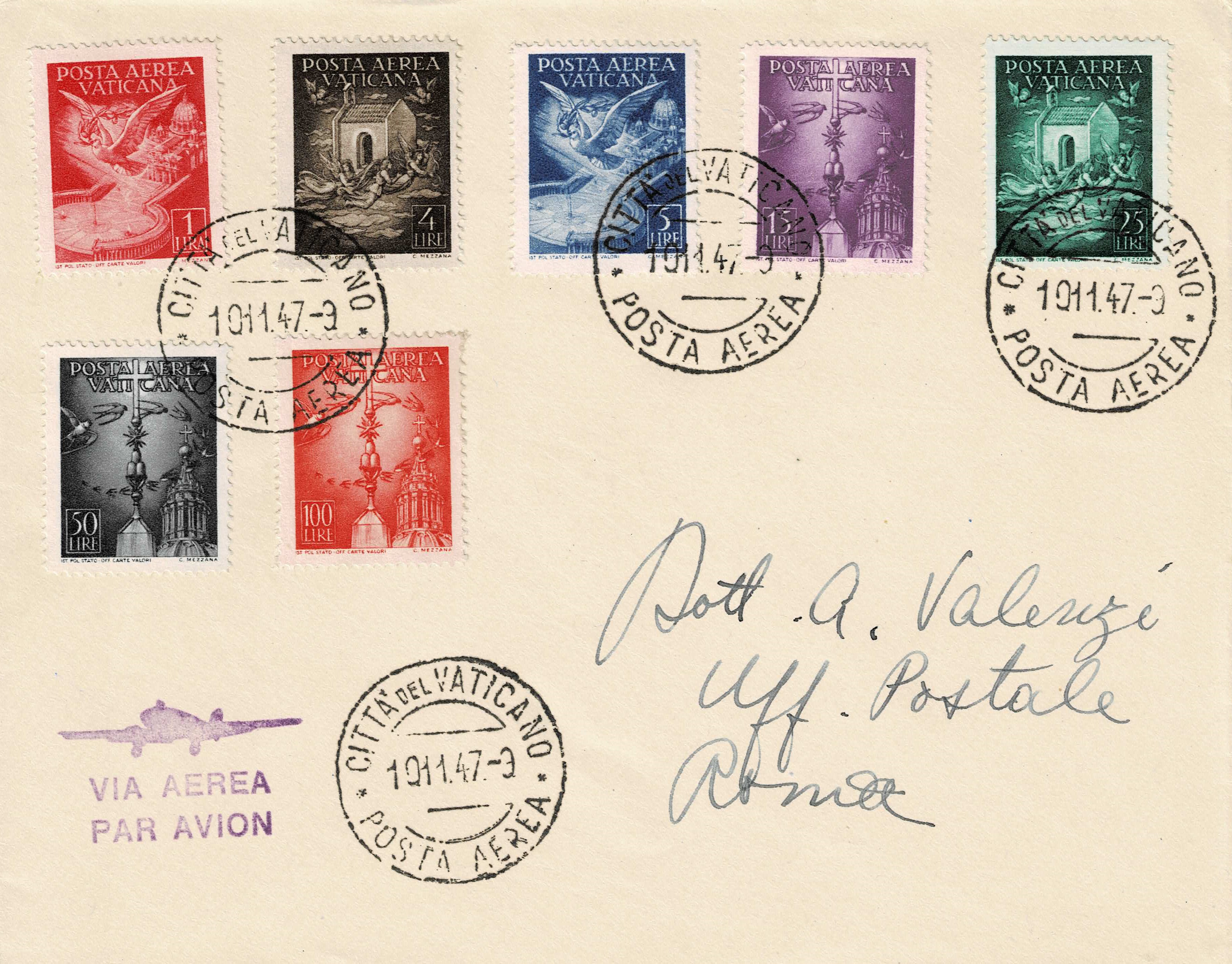


Archangel Raphael
Originally, the airmail series of 1947 was to include stamps of a higher face value than 100 lire but due to philatelic protests they were not released at the same time. It was not until December 28, 1948, that Vatican City released the badly needed values of 250 and 500 lire. This series of two stamps depicts the Archangel Raphael accompanying Tobias the Younger, on his journey to the city of Rages.
Tobias the Elder was a God-fearing man who found favor in the sight of God by feeding the hungry, clothing the naked, and burying the dead during the Assyrian Captivity. To test his patience, God allowed him to be blinded by hot dung falling from a swallow's nest.
Thinking that he was about to die, he wanted to send his son, Tobias the Younger, to the City of Rages to collect a debt owed him and desired a companion to accompany him. God sent the Archangel Raphael in human form and it was arranged that he should join the Younger Tobias on his journey. The three (Raphael, Tobias the Younger, and his dog) started their journey to Rages. The first night they camped by the Tigris River where they caught a large fish. Raphael instructed Tobias to save the heart, gall and liver of the fish as "necessary for useful medicines."
Upon reaching Rages, Raphael prompted the Younger Tobias to marry a girl by the name of Sara who had been married seven times but each husband was killed on the wedding night by the devil Asmodeus. On their wedding night the Archangel burned part of the liver in the room where they spent their first three nights in prayer and self-restraint. By thus overcoming their lusts, Sara was free from the persecution of the devil.
After Tobias collected the debt owed his father they all started for home. Halfway home, Raphael, Tobias, and the dog raced ahead to see the parents of Tobias. When the joyful reception was over, he anointed his father's eyes with the gall of the fish and the Elder Tobias' sight was restored. When Raphael was asked what reward he desired he revealed himself by saying: "I am the angel Raphael, one of the seven who stand before the Lord." He then departed.
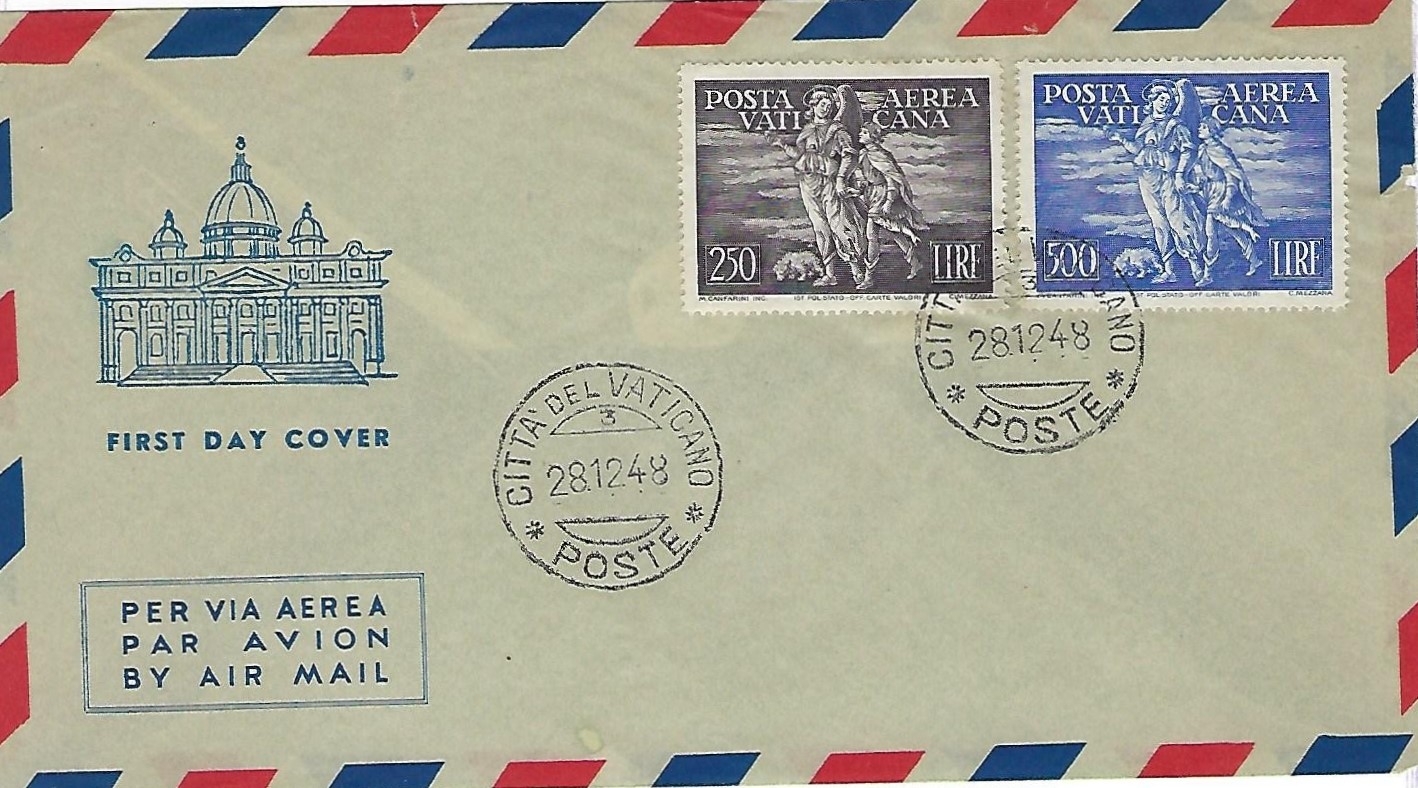

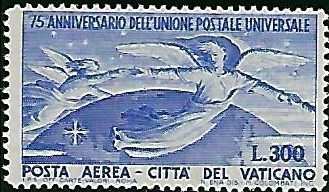

Universal Postal Union
To mark the seventy-fifth anniversary of the Universal Postal Union, the Vatican City released a set of two air-mails on December 9, 1949, of the denominations of 300 and 1,000 lire. In 1862, the United States suggested a postal convention to various nations to adopt a method of simplifying the international mails. The convention met the following year in Paris and adopted a code containing thirty-one articles that was to form the basis of international postal conventions. In September 1874, twenty-two nations met in Switzerland at the Congress of Bern. As a result of this Congress, an international postal union was formed by adopting the methods used by the German Postal Administration for solving the transportation of mails between its individual states before they had been united. The Universal Postal Union thus was formed by a treaty of twenty articles, nineteen of which were ratified on May 3, 1875, and the twentieth being ratified on July 1st of the same year. Agreements are renewed every five or six years at a Congress of the U. P. U.
Within ten years, eighty-six nations had joined this international organization. By the year 1900, the participating nations had jumped to one hundred thirteen. Vatican City became a member on June 1, 1929. Today the Universal Postal Union is composed of most of the nations of the world.
At the twelfth Congress in Paris, it was decided to request all participating nations to issue stamps to mark the seventy-fifth anniversary of this, the only international organization to exist in complete accord with the world.
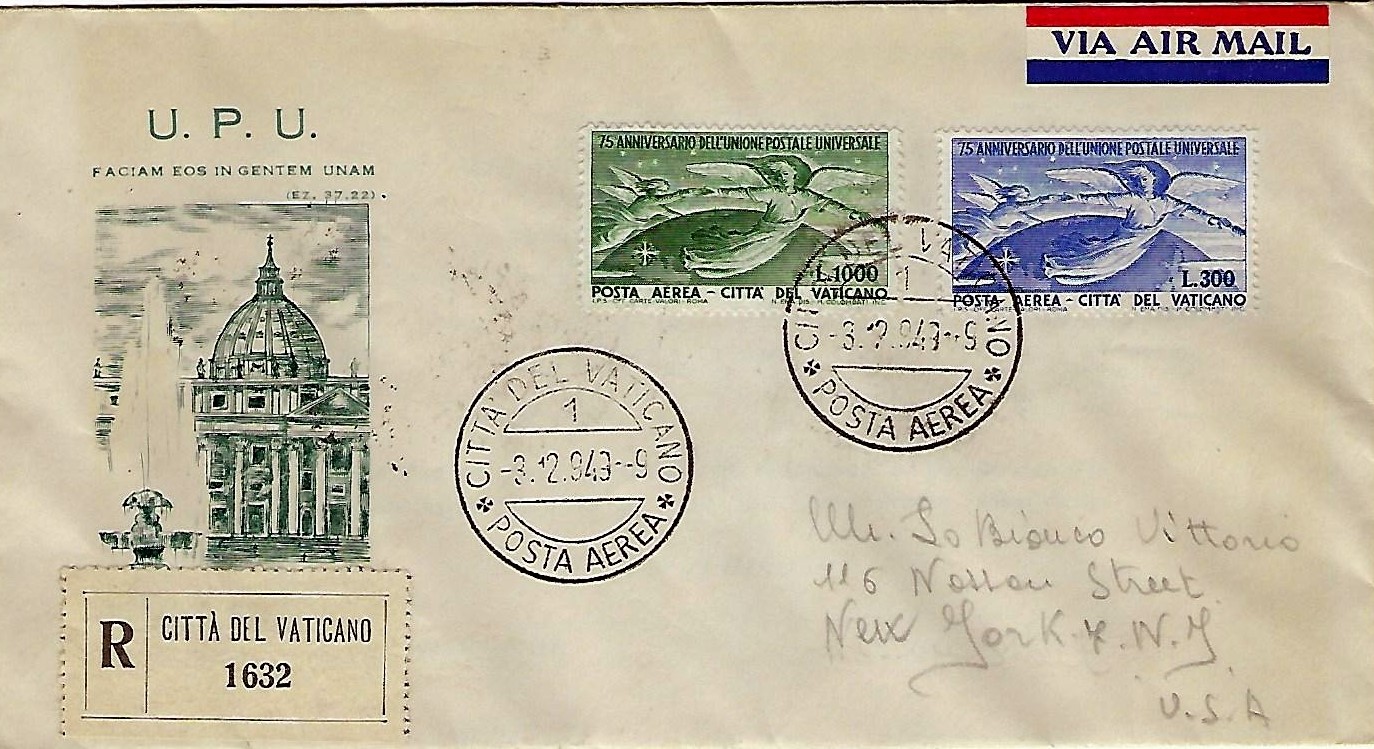

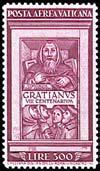
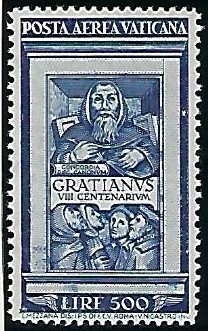
Gratianus
The eighth centenary of the publication of the "Decretum Gratiani" was commemorated by an issue of two air-mail stamps on December 20, 1951. Francis Gratian (Franciscus Gratianus) was born in central Italy, near Florence, at the beginning of the twelfth century. Little is known of his early life until he became a Camaldolese Monk, an order of barefooted hermits founded in 1012. Because of his great knowledge and resourcefulness he was called to teach Theology at the University of Bologna, and resided at the Camaldolese Monastery of Saints Felix and Nabor.
Later he assembled all the existing Church Laws that had been adopted since the beginning of the Church and placed them in a neat and orderly form. This work became known as the Decretum Gratiani, (Decree of Gratian). Although this tremendous undertaking was widely used and regarded as authoritative, it never was officially sanctioned and adopted by the Holy See. Even so, this first real attempt at codification of Canon Law earned for Franciscus Gratianus the title of, "Codifier of Canon Law."
Upon his death in 1160, a monument was erected in his honor in the Church of St. Petronius in Bologna.
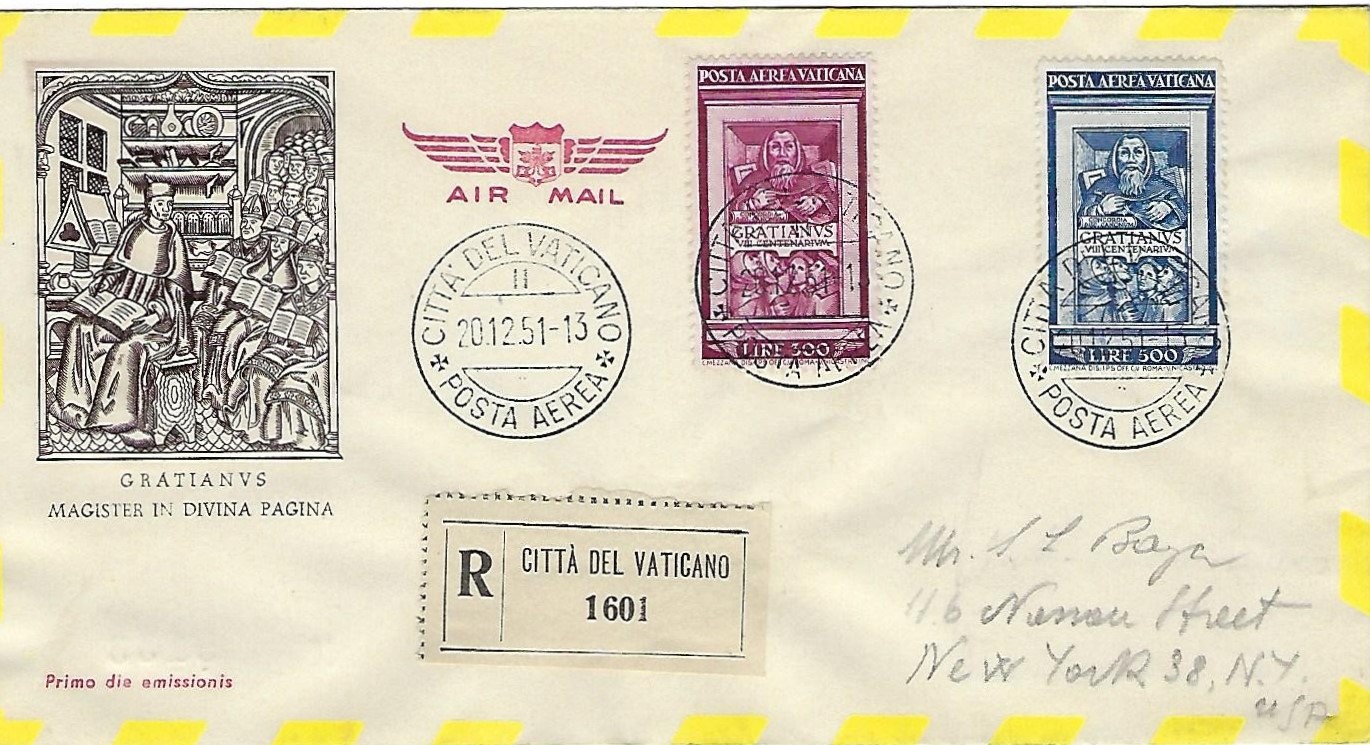



St. Peter's Dome
On August 10, 1953, just four months after the release of the definitives telling the history of St. Peter's Basilica, a set of two airmails depicting the dome was released.
It is very appropriate that this segment of the basilica honoring the first Pope have an issue of its own. Respectfully called, "Michelangelo's Dome," it is the most impressive architectural feat ever undertaken on the Italian peninsula.
The first thought of erecting a crown in the form of a dome over the tomb of the first Apostle dates back to 1503, when Pope Julius II engaged the noted Bramante to design and erect a new basilica to replace the one built by Constantine. Bramante's plan called for a dome directly over the tomb of St. Peter. He never saw his plan materialize as he died long before it could be started.
For almost a half-century the dome, or cupola as it is sometimes called, was not heard of again. During the Pontificate of Pope Paul III, Michelangelo was appointed to supervise the planning and building of this new edifice. He was given complete authority to alter, remodel, or demolish any part of the church that did not conform precisely with his plan. As a result, a number of changes were made including the scrapping of Bramante's plans. Before the cupola could be completed Michelangelo was called to his final reward at the age of 89.
After his death in 1563, nothing more was added to the dome for a period of twenty-four years. During this time only the drum of the dome erected before Michelangelo's death was completed leaving the work in progress below exposed to the varying havocs of the seasons and elements.
In 1588 Pope Sixtus V became impatient and ordered the work on the dome to be finished. The order further stipulated that the plans and measurements laid down by the deceased genius were to be strictly adhered to. As a result of this Papal order, the dome was completed in a period of twenty-two months.

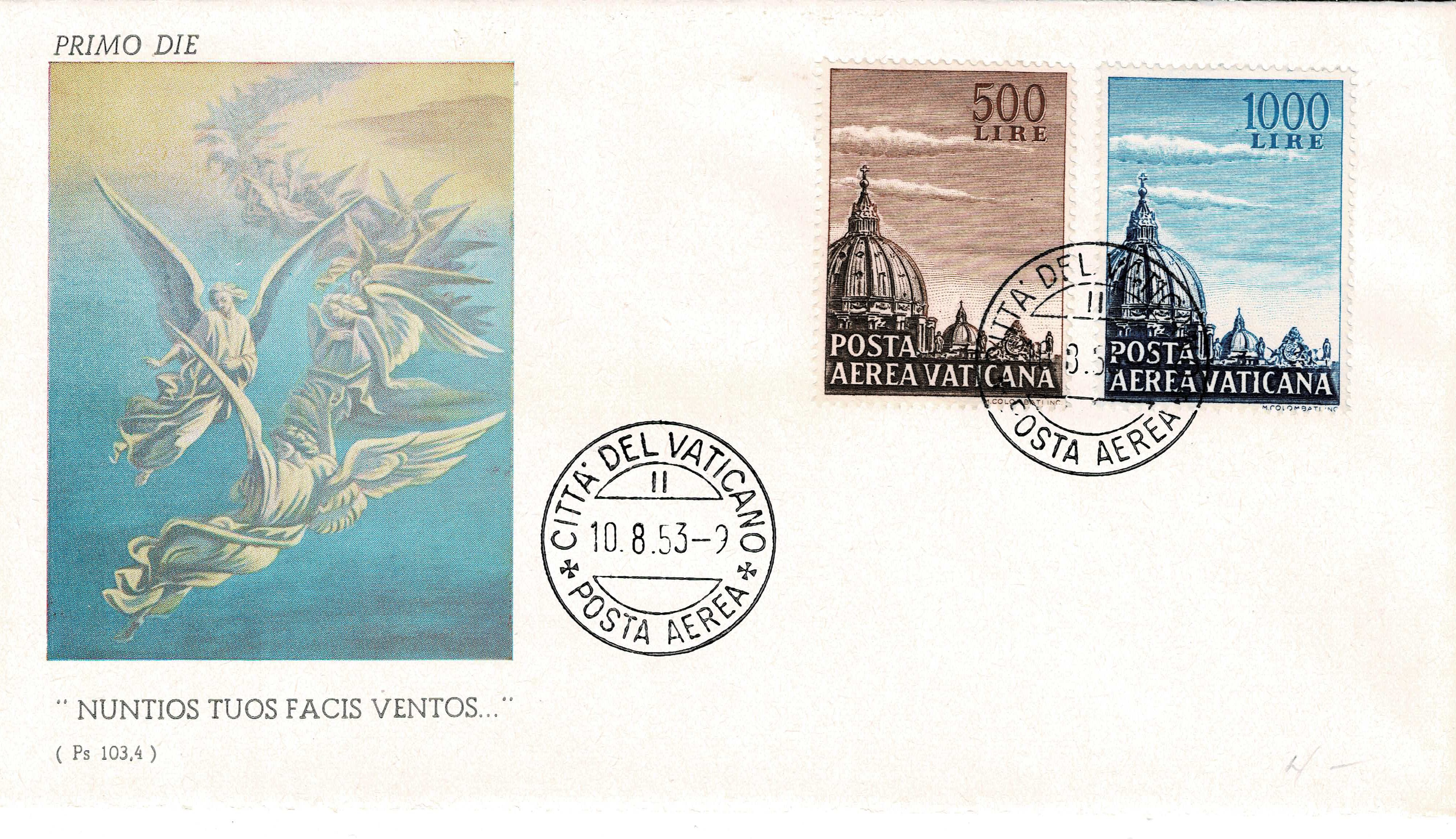

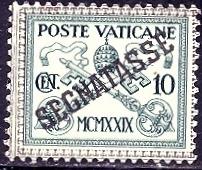
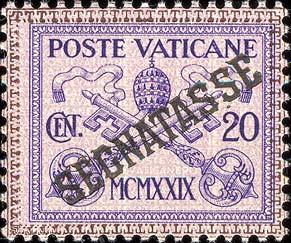



Postage Due Stamps
In addition to the regular, commemorative, and airmail stamps mentioned, the Vatican City State also has issued four sets of postage-due stamps. The first of these were framed "SEGNATASSE" overprints applied to six values of the Conciliation issue and released on October 1, 1931:











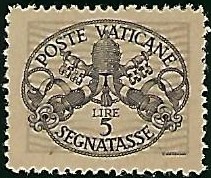













Postage Due - Papal Arms

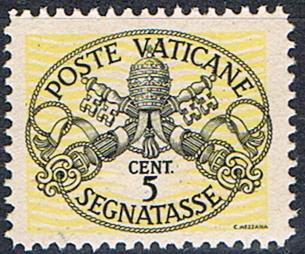


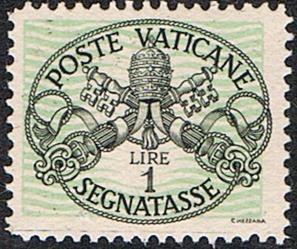
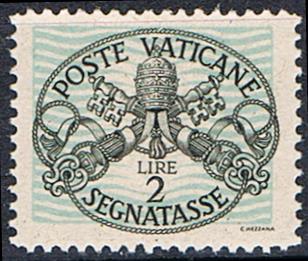
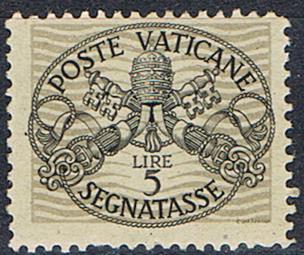
Postage Due - Papal Arms - Thicker Lines
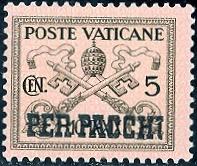
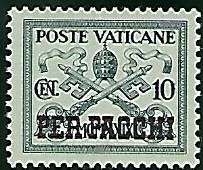
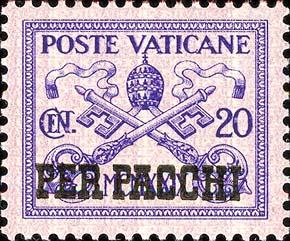
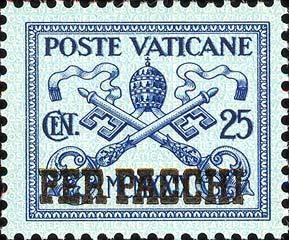
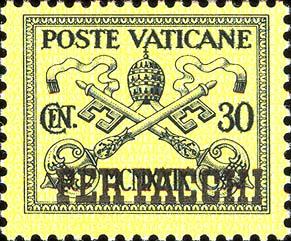
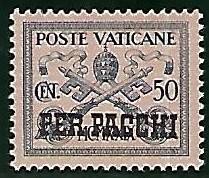
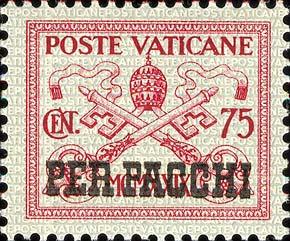
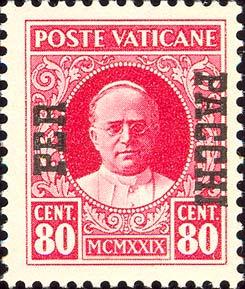
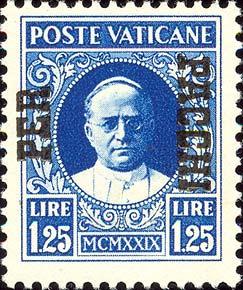
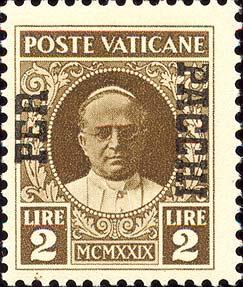
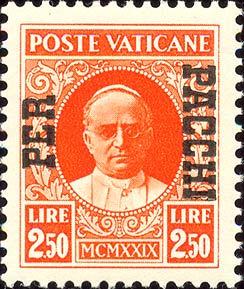
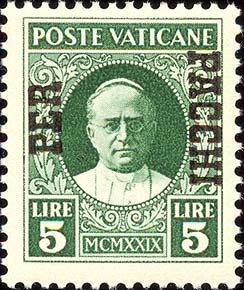
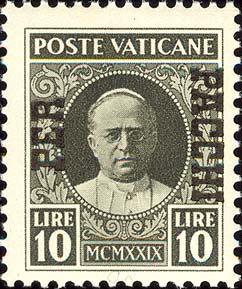
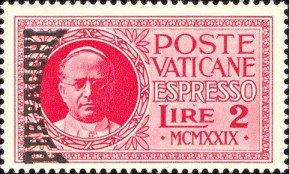
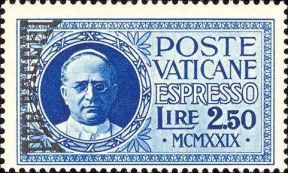
Parcel Post Stamps
The entire Conciliation issue was overprinted "PER PACCHI" and released on October 1, 1931, for parcel post use. This issue was made necessary by an attempt of the Vatican Postal Administration to simplify records of parcel post handling.




Special Delivery Of 1933
The second set was issued in 1933, and its two denominations depict an aerial view of the Vatican City State. This plot, small as it is, was described by Pope Pius XI as "that much territory as we need as a basis of sovereignty; that much without which we could not exist .. . that much body required to keep the soul together." Recess-engraved, values are 2-lire, rose-red and brown, and 23-lire, deep blue and brown.


Special Delivery Of 1945
In 1945 the same design was used for 3-1/2-lire, carmine and ultramarine, and 5-lire, ultramarine and green denominations, and later the same year, these were overprinted to change their values to 6 and 12-lire, respectively.




Special Delivery




Special Delivery - Council of Trent
Two more special delivery stamps were issued as part of the Council of Trent series. The 6-lire, dark green, portrays Matteo Giberti, Bishop of Verona, originator of the modern care of souls. In his diocese he patterned his model of Reform after that of the Fathers of the Council. The 12-lire, copper brown, portrays Casper Contarini (1438-1542 ), nobleman of Venice who was elevated to a Cardinal from the lay state. As Bishop of Belluno he was noted for his action for the Reform and a great supporter of Pope Paul II's efforts for the Council.




Special Delivery - Roman Basilicas
In 1949, two of the "Basilicas" set were prepared for special delivery serv-ice. They are 40-lire, slate, an aerial view of St. Peter's Square and Basilica, and 80-lire, chestnut-brown, Basilica of St. John Lateran, the Arch-basilica in Rome and Cathedral Church of the World.




Special Delivery - Popes & Basilicas
In 1953, two of the "Pope of the Basilicas" set, and are described on preceding pages. Values are: 50-lire, green and brown, St. Peter and his tomb; 85-lire, orange and brown, Pope Pius XII and Roman Sepulchre.






Holy Year Semi-Postals
On April 3, 1933, Vatican City issued its only set of semi-postal stamps. They were engraved on unwatermarked paper and depict the orb and cross in an oval. Values are: 25-plus-10 centesimi, green; 75-plus-15c, scarlet; 80-plus-20c, red-brown, and 11/4-lire-plus-25c, ultramarine. The surtax was used to help defray costs of Holy Year expenses.
The Holy Year of 1933 was a special one, that is, it was not the one proclaimed every twenty-five years. This Holy Year, the first since the Vatican City became an independent nation, marked the nineteenth centennial of the Crucifixion and Resurrection of Christ. In addition to commemorating this event, the jubilee had as one of its main reasons the praying for continued peace in the face of war that was fast approaching.

